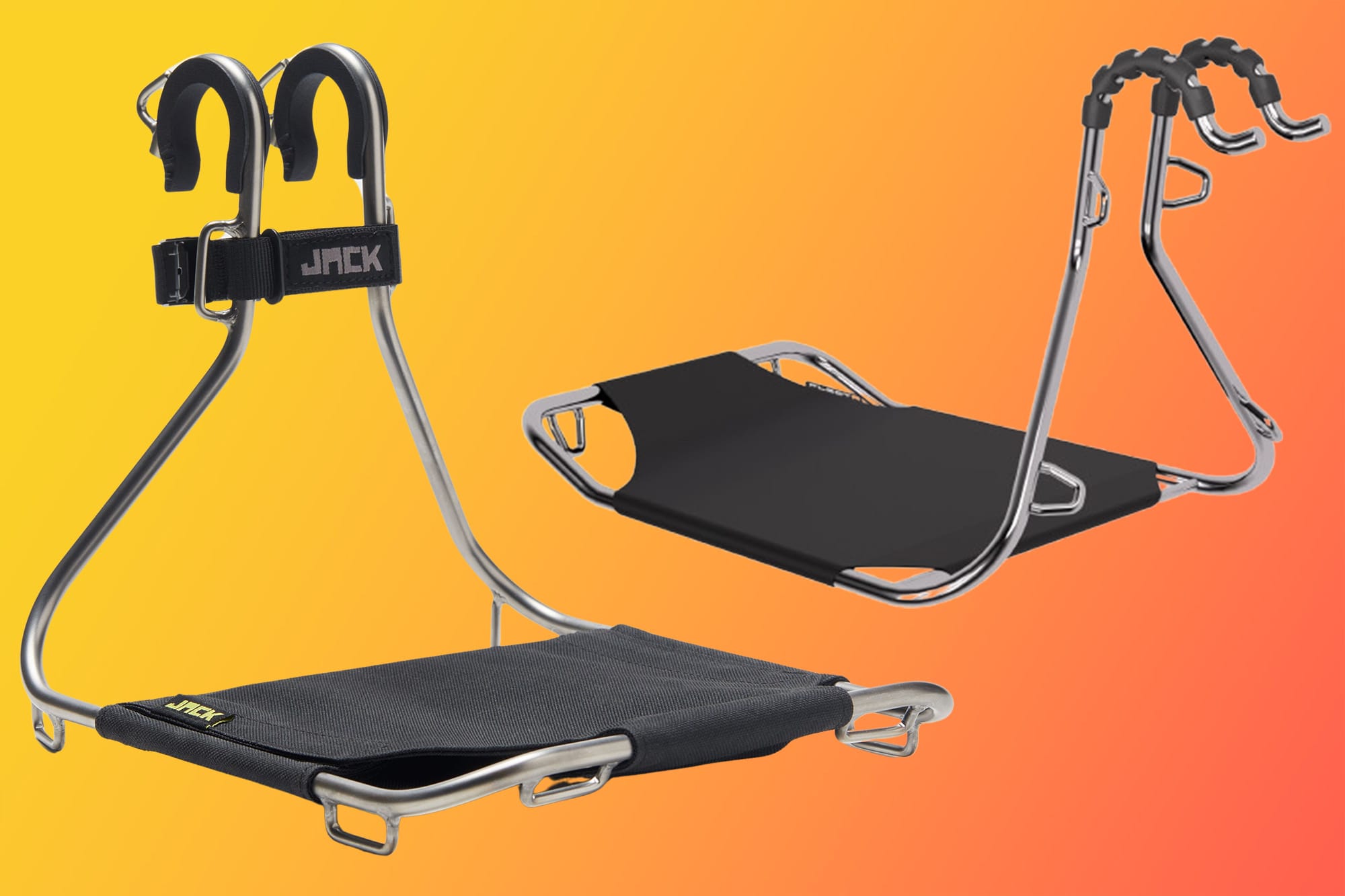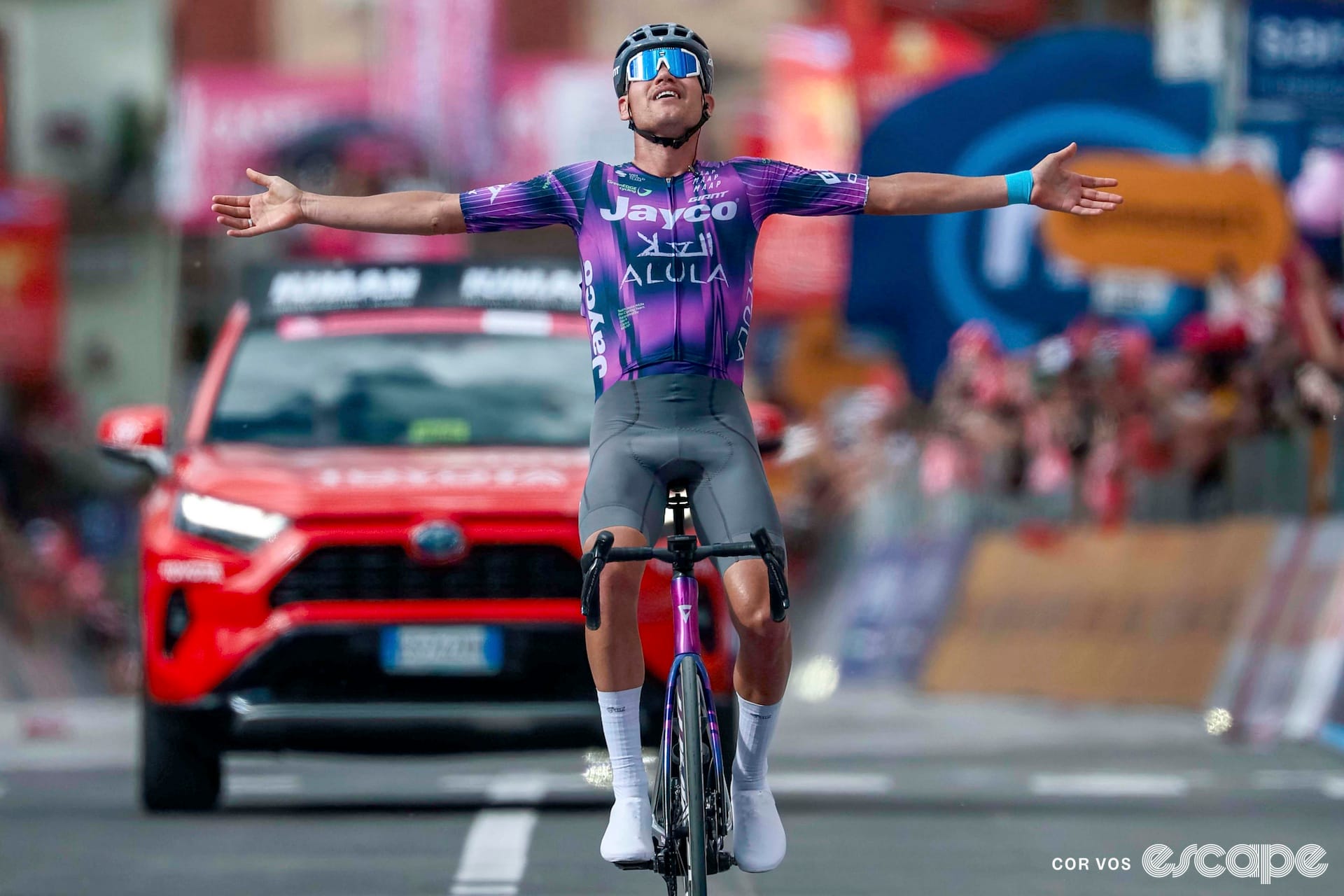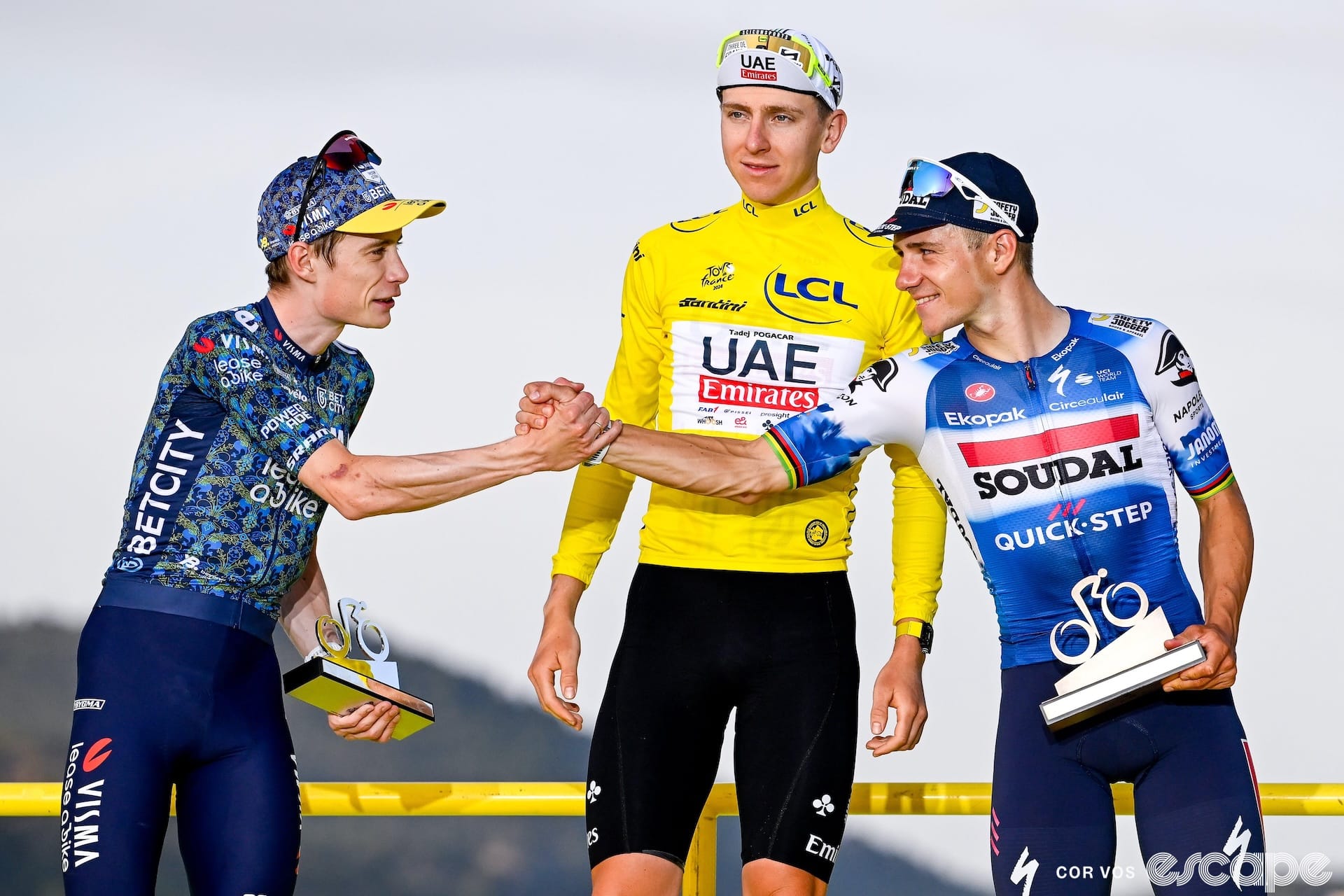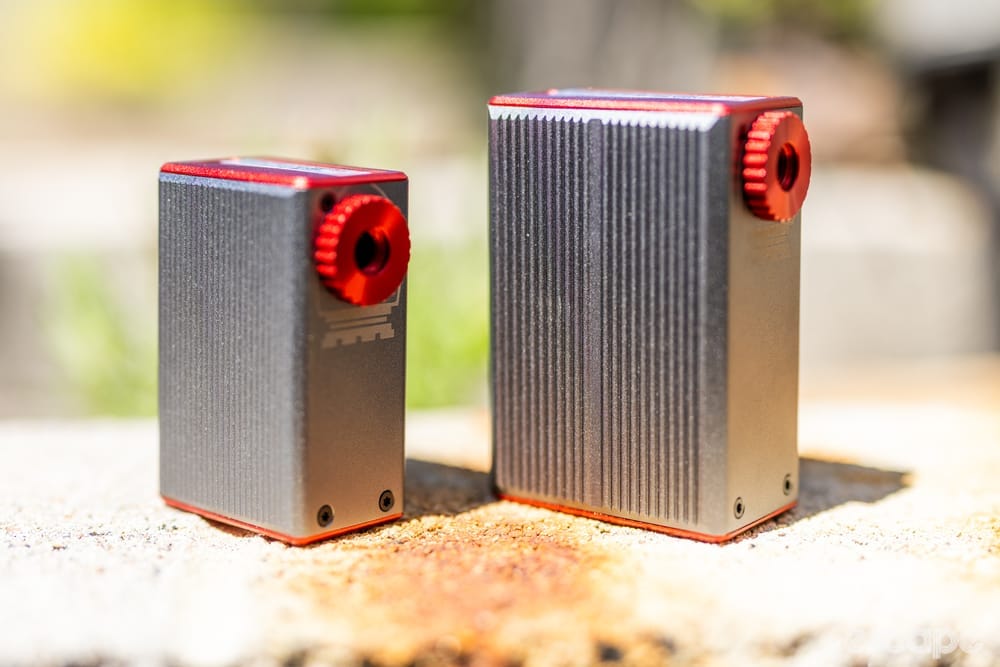Ever get the feeling some things are just meant to be and will never change? I’m thinking Ridley sponsoring Lotto Dstny and Ridley offering Helium-badged all-rounder bikes. These things seem as certain as death and taxes until suddenly, without warning, what was once certain is no more.
Within the space of two weeks, Lotto has detonated its long-standing partnership with Ridley, and Ridley has discontinued the Helium. What the heck!?
But, as the old saying goes, “it’s a strange wind that doesn’t blow some good.” The Helium is gone, but in its place, Ridley has officially unveiled the new Falcn RS, a “light-aero," "do-it-all” sort of offering, specifically developed in partnership with (and presumably “for,") the Lotto Dstny squad and first seen at the Critérium du Dauphiné and already ridden to victory on stage 2 of the Vuelta a España.
Good stuff: An inspiring race bike, performance-focused geometry, ticks the boxes without going over the top in any area, option to spec your handlebar size. Does UDH fall into "Good stuff?" Looks great!
Bad stuff: Oh the price, should have a power meter at this price, still with the press-fit bottom brackets, and truly fully internal cable routing.
While the two seismic events are almost certainly unrelated, that comes as little consolation to Ridley, whose CEO, Jochim Aerts – whose birthday the new bike launch coincides with, happy birthday – specifically mentioned the work and motivation behind the new bike in bringing more success to Lotto Dstny riders in the years to come.
So then, with so much change all at once, will the new Falcn RS be Lotto’s loss and another team’s gain, and more importantly to us, what's it all about and how does it ride? Ridley supplied Escape Collective with the new bike in advance of today’s launch. Here's what we know and our thoughts on the new bike on the road.
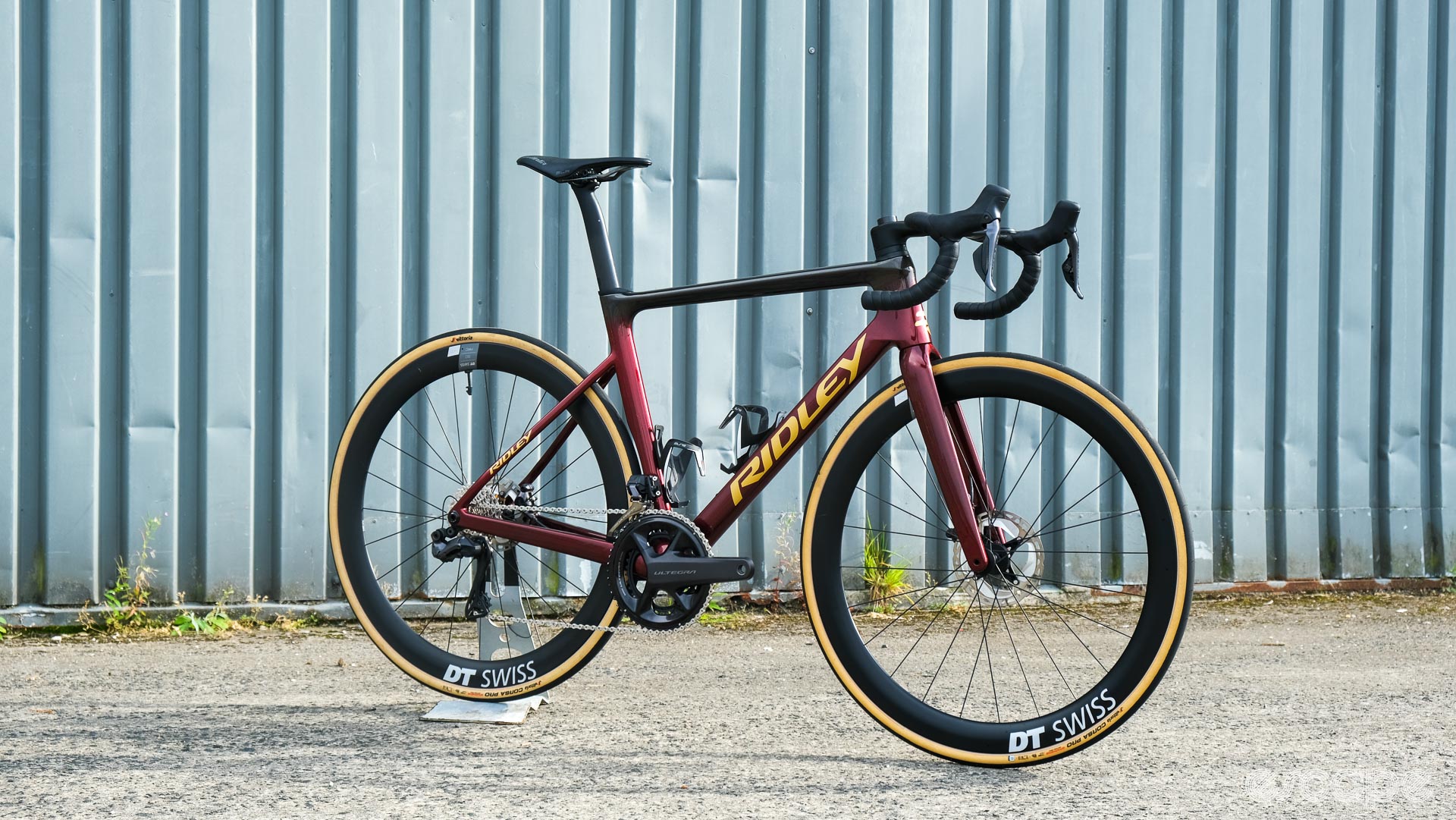

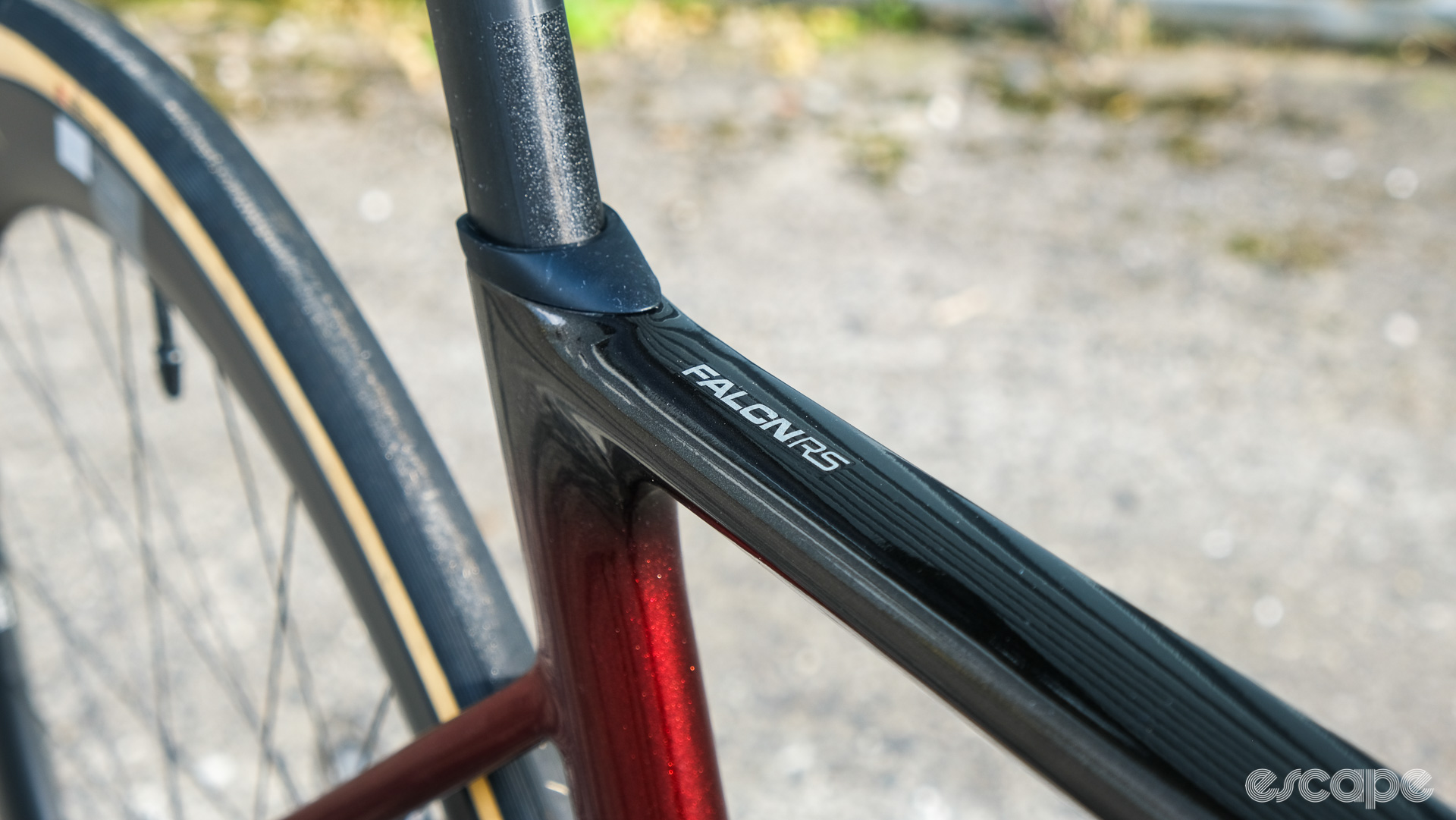
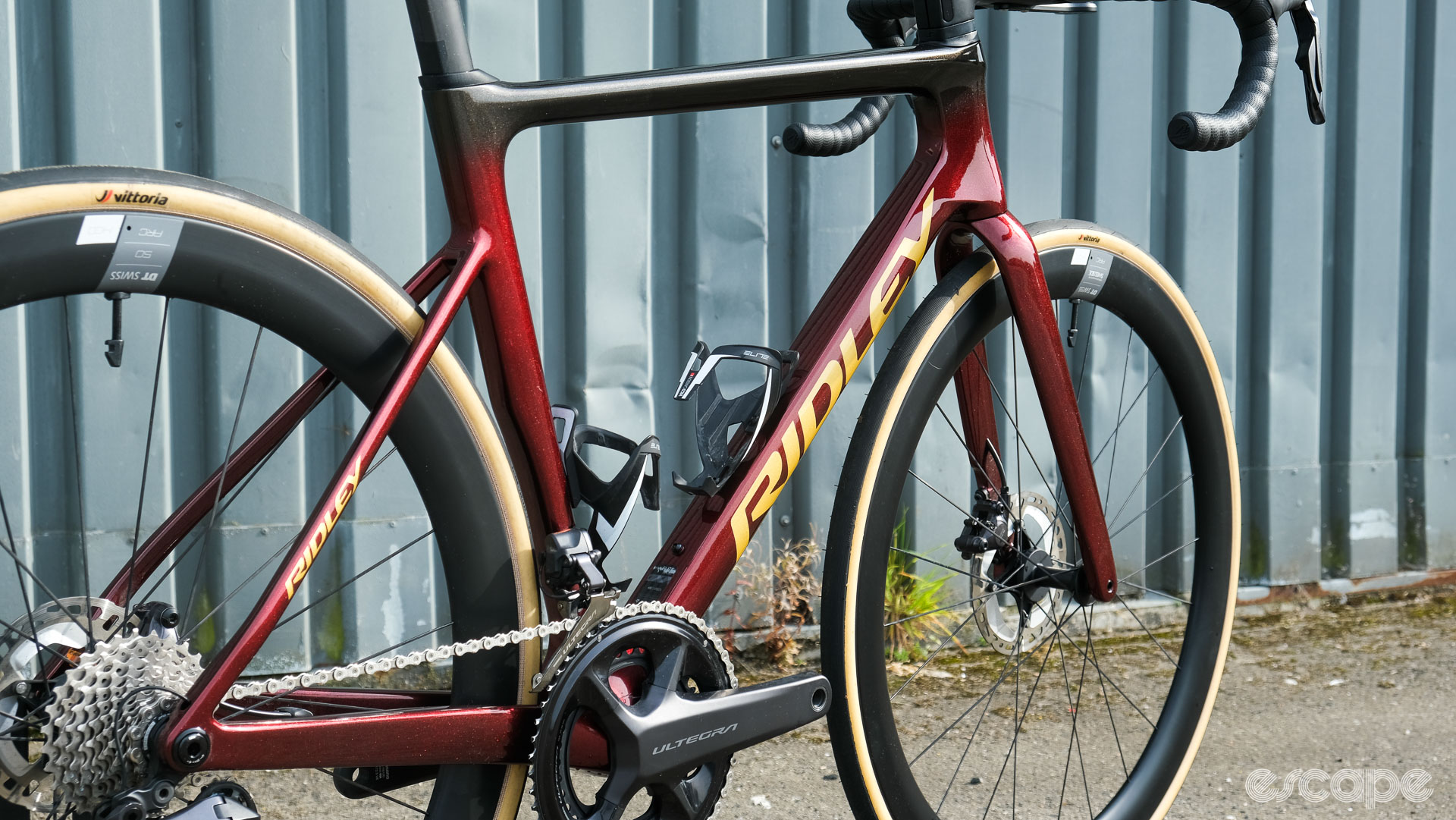
Doing it all, they're all doing it.
If you haven’t noticed, we are very much in the era of the “all-rounder” style bike. Granted, before we endured/enjoyed (strike out as appropriate) the dedicated aero and separate climbing bike era, every bike was an all-rounder. But just as it seemed every brand had completed its lineup of climbing and aero-specific offerings, they all started doing the do-it-all offering. Lighter than a dedicated aero bike, more aero than a dedicated climbing bike, and with clearance for tyres wider than we could legally race in a cyclocross field.
The new Falcn RS is one such do-it-all bike, or “aero-light” bike, as I like to call them. While Ridley will continue to offer its Noah Fast aero frame (with a new model confirmed to Escape as already in the works), the design brief for the Helium replacing Falcn RS was to produce a “versatile and fast-performing bike that can handle any kind of road racing.” As you might expect, Ridley identified aerodynamic efficiency, reduced weight, increased tyre clearance and stiffness, all in a package offering performance-focused geometry, as the key components for a bike designed to tackle cobbled classics and Alpine cols alike.
As an aero nerd with a weight weenie heart, I am yet to be convinced that a do-it-all bike doesn’t inherently mean “jack of all trades but a master of none" for the professionals racing on such varied terrain. But to be fair, such balanced offerings make a lot of sense on paper, especially for team staff who can instantly halve the number of road bikes they tow around on tour and even more so for most of us who will only ever own one road bike at a time.
Aero to weight
Ridley says it specifically focused on the aero-to-weight characteristics of the new frame. In fact, if Ridley is to be believed, the age-old stiffness-to-weight metric is seemingly dead, and the balance between a frame's aerodynamic properties and its weight is the new benchmark. To that point, Ridley claims the new Falcn offers similar aero performance to the brand’s dedicated aero bike, the Noah Fast Disc, and a weight “comparable” to that of the Helium SLX Disc.
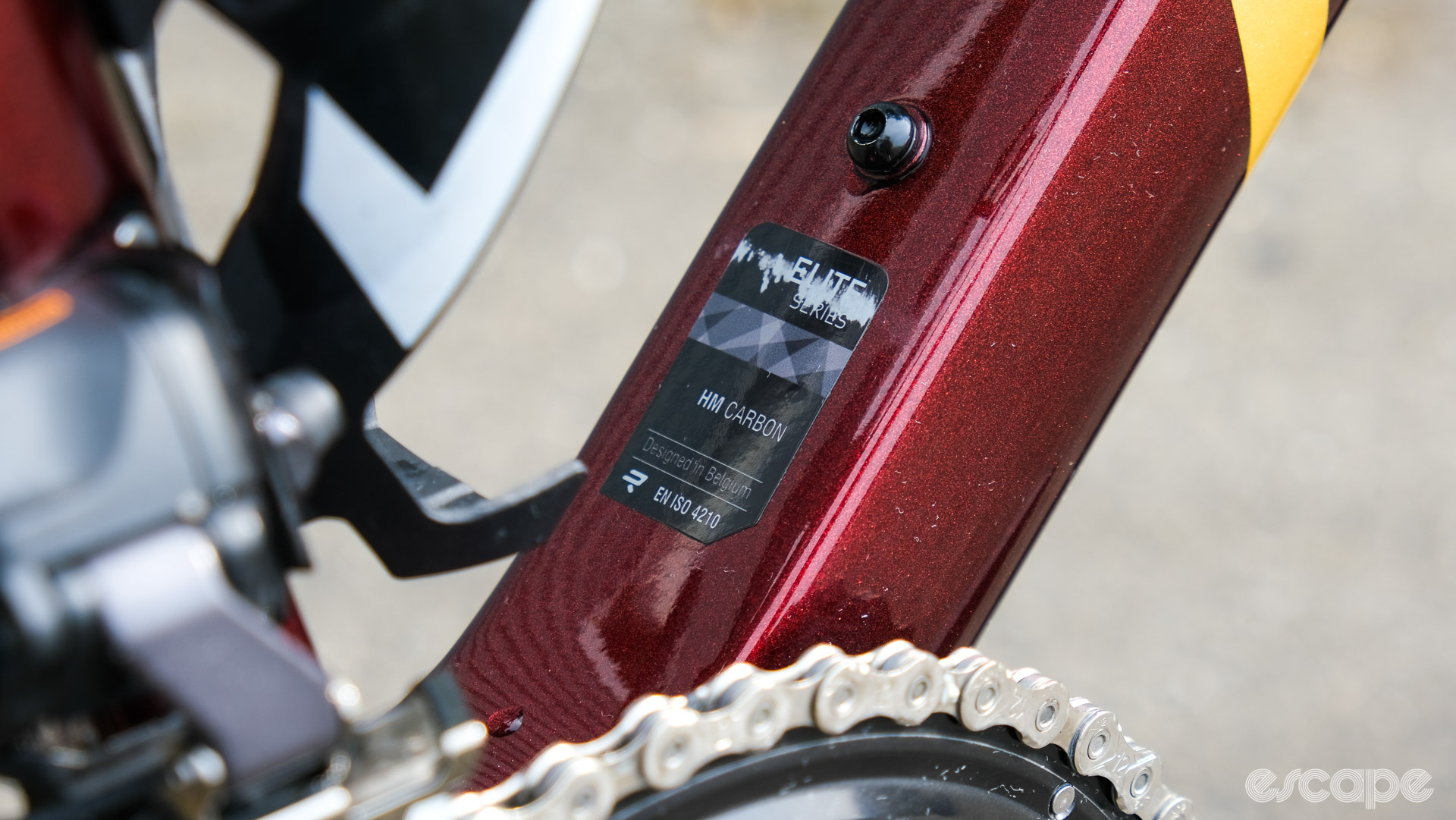
In actual stats the Falcn frame and fork total is 110 grams heavier than the Helium with a claimed 825-gram size medium frame and a 380-gram claimed weight for the fork. This Ridley-size medium (think large) Ultegra Di2 test bike equipped with a 30 mm rear tyre, bottle cages, and a computer mount, weighed in at 7.4 kg: hardly featherweight, but it's hardly decked out like a weight-weenie special either.
The result, according to Ridley, is a bike that, despite the slight weight penalty, actually climbs faster than the Helium and sets a new threshold in the weight v. aero tipping point calculations. The Col du 8%, first coined by Josh Poertner, now of Silca, was so called because 8% was the gradient Poertner had calculated beyond which reducing the weight of a pro’s bike was faster than reducing aerodynamic drag. Ridley claims the new Falcn’s aero balance increases this tipping point further up the gradient scale, suggesting the new bike is faster across the range of gradients and wattages than the outgoing Helium SLX or the Noah Fast Disc. Ridley provided the graph below plotting the aero versus weight turning point for the new Falcn, based on Arnaud De Lie’s CdA and weight.
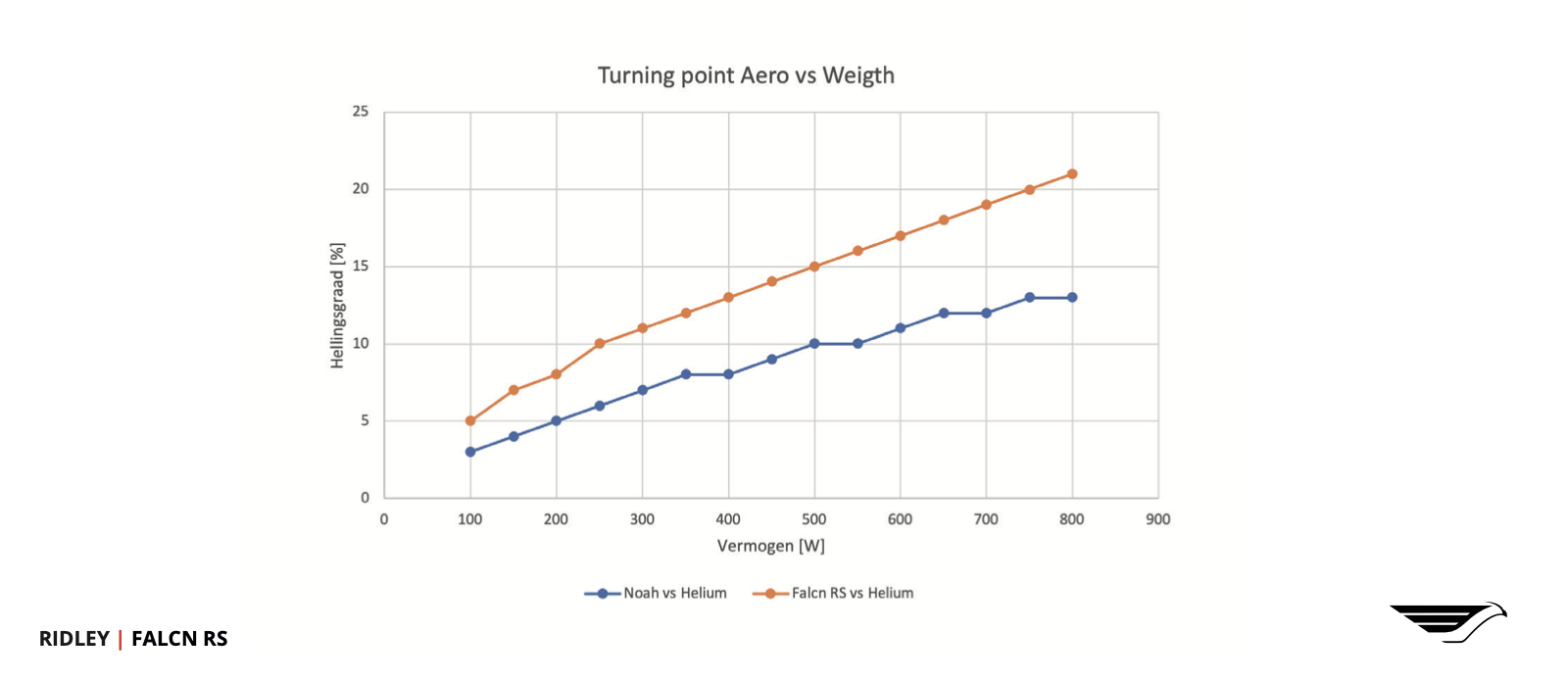
So how has Ridley got there? The press release provided along with the new Falcn RS speaks of, as you might expect in 2023, CFD analysis and wind tunnel testing. Ridley has used that analysis and testing to eke out an aero-optimised frontal profile mated to a “general frame design” developed to reduce weight without hampering those aero properties. That seems like another way of saying the frame utilises truncated aero profiles and many of the other design tweaks that are now commonplace on the “aero-light” offerings from many brands. The deeper and narrower head tube, dropped seat stays, and truncated tubing profiles all make an appearance, but this is far from a copycat or tick-box design.
Ridley claims every cross-section of the frame is “aero optimised with carefully chosen aerofoils” and includes a top tube profile specifically designed for “increased stability in cross winds." The dropped stays and truncated seat tube featuring a rear-wheel cutout are designed to maintain the aero gains while also handily helping reduce the weight in the rear half of the frame.

So far, so normal, the new Falcn RS is seemingly a no-frills-attached solid design utilising many of the tried and tested modern design features without any truly divisive ones. Well, yes and no, there is one aero “pièce de résistance” if you know where to look. The fork crown diffuser, as Ridley has named it, is easily mistaken for a design feature to offer extra tyre clearance, it is, though, an aero feature Ridley claims reduces aero drag behind the fork and over the down tube.
Ridley claims the rearward-facing surface on typical fork crown designs creates turbulence in the airflow, which results in extra drag as the flow effectively sucks on the rear of the fork. This new fork crown isn’t all that different to a traditional crown, There’s no change in axle to crown or head tube measurements; Ridley has just removed some of the extra surface area on the rear section of the crown to create a taller channel. It’s this taller channel that Ridley claims acts like a diffuser. By opening up this area, the diffuser is said to energise the airflow through this region, which in turn reduces the turbulence and helps reduce drag on the fork and down tube.
Furthermore, as Daan Teugels, R&D engineer at Ridley, explained to Escape, the energised airflow created by the “diffuser” actually helps increase the pressure in the low-pressure zone behind the fork profile, which in turn helps smooth the airflow over the entire region as it reduces the tendency for flow over the outside of the fork to leak inward through the low-pressure zone and onto the frame.
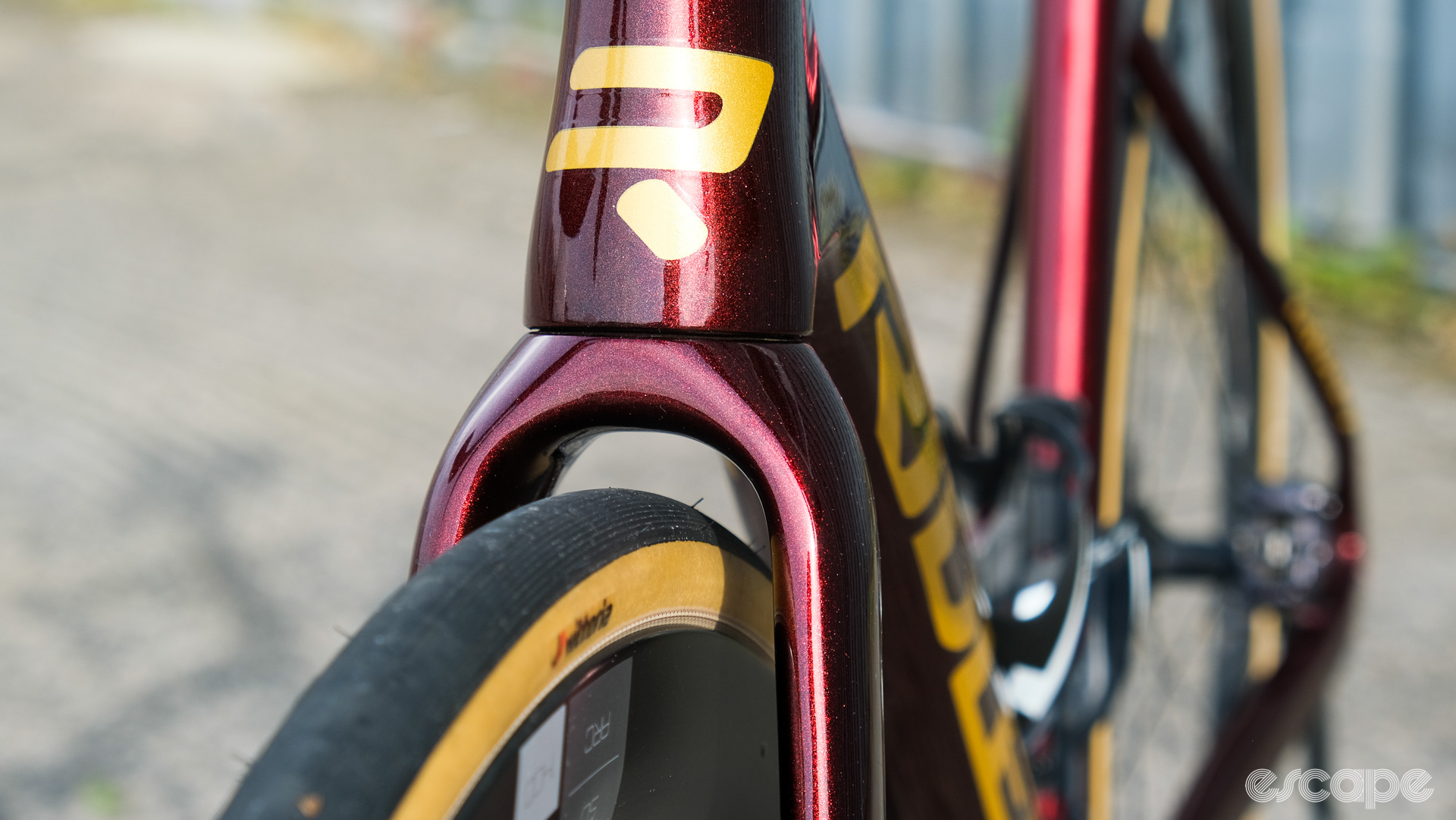
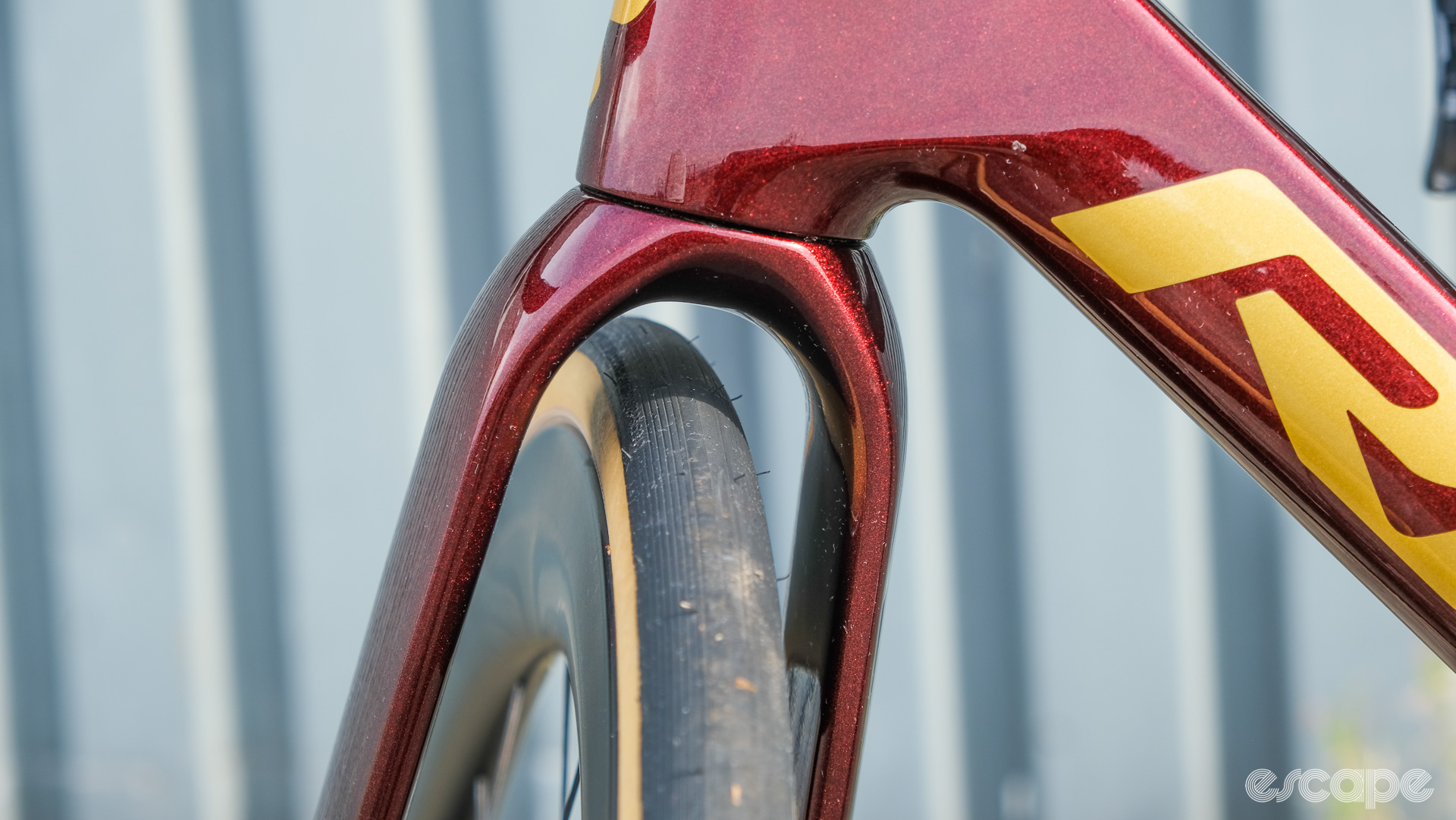
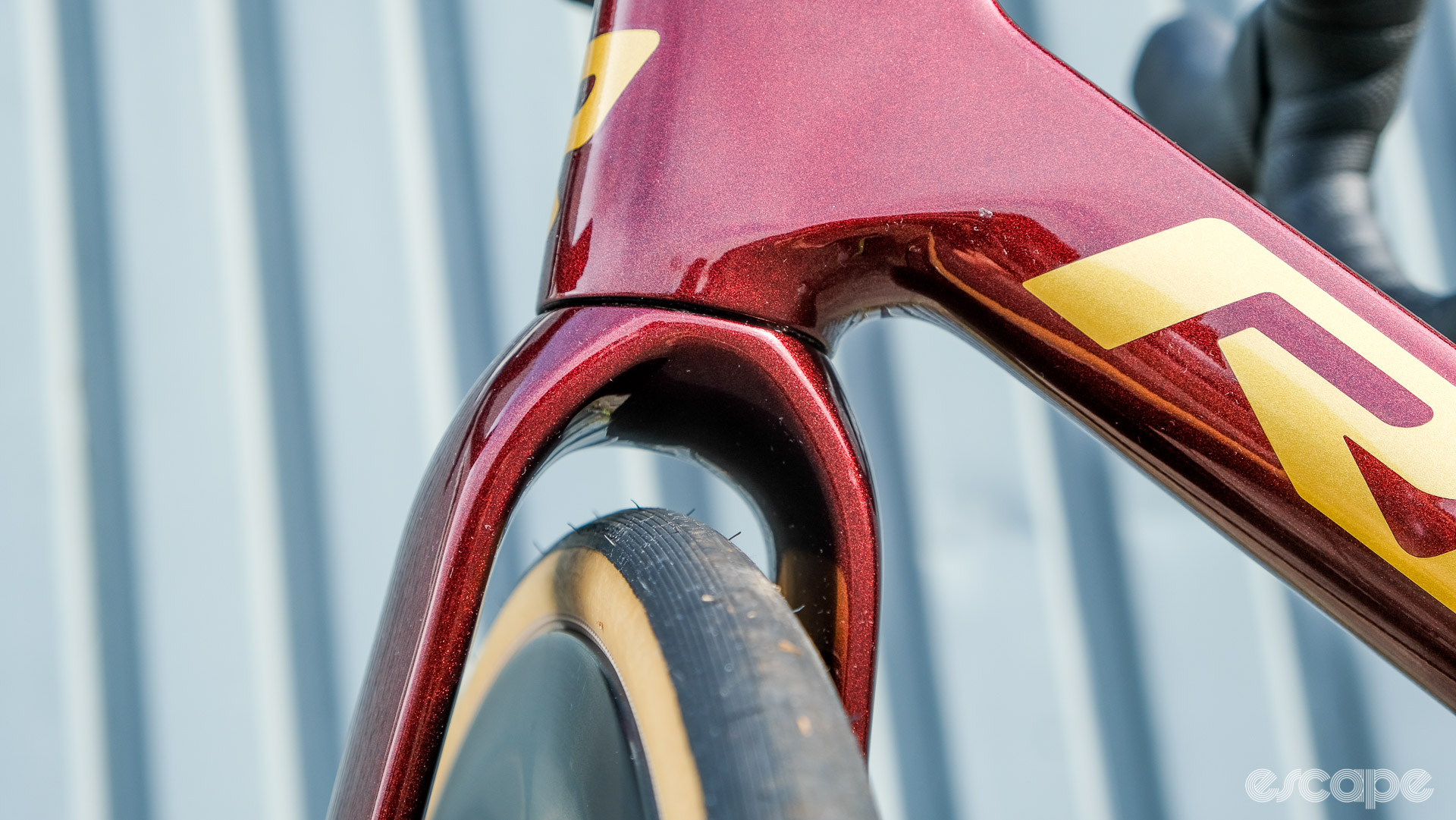
This diffuser is said to reduce drag by as much as 10% at 50 km/h compared to the original fork design. Whether it works or not, that a full 10% is realised when moving from CFD to the real world is one for the aerodynamicists to debate, but at least it’s not as “in-your-face” or divisive as some of the aero interventions we have seen on other frames of late. One word of warning, though. Naturally, like any diffuser, Ridley’s new crown works the airflow by channelling it through an opening, between the tyre and fork crown in this instance. The Ridley design is optimised around a 28 mm tyre, so maxing out the Falcn’s 34 mm tyre clearance will fill this channel and eradicate some or all of the aero gains. Whether or not that matters to you probably comes down to whether or not you believe in such design features to begin with.
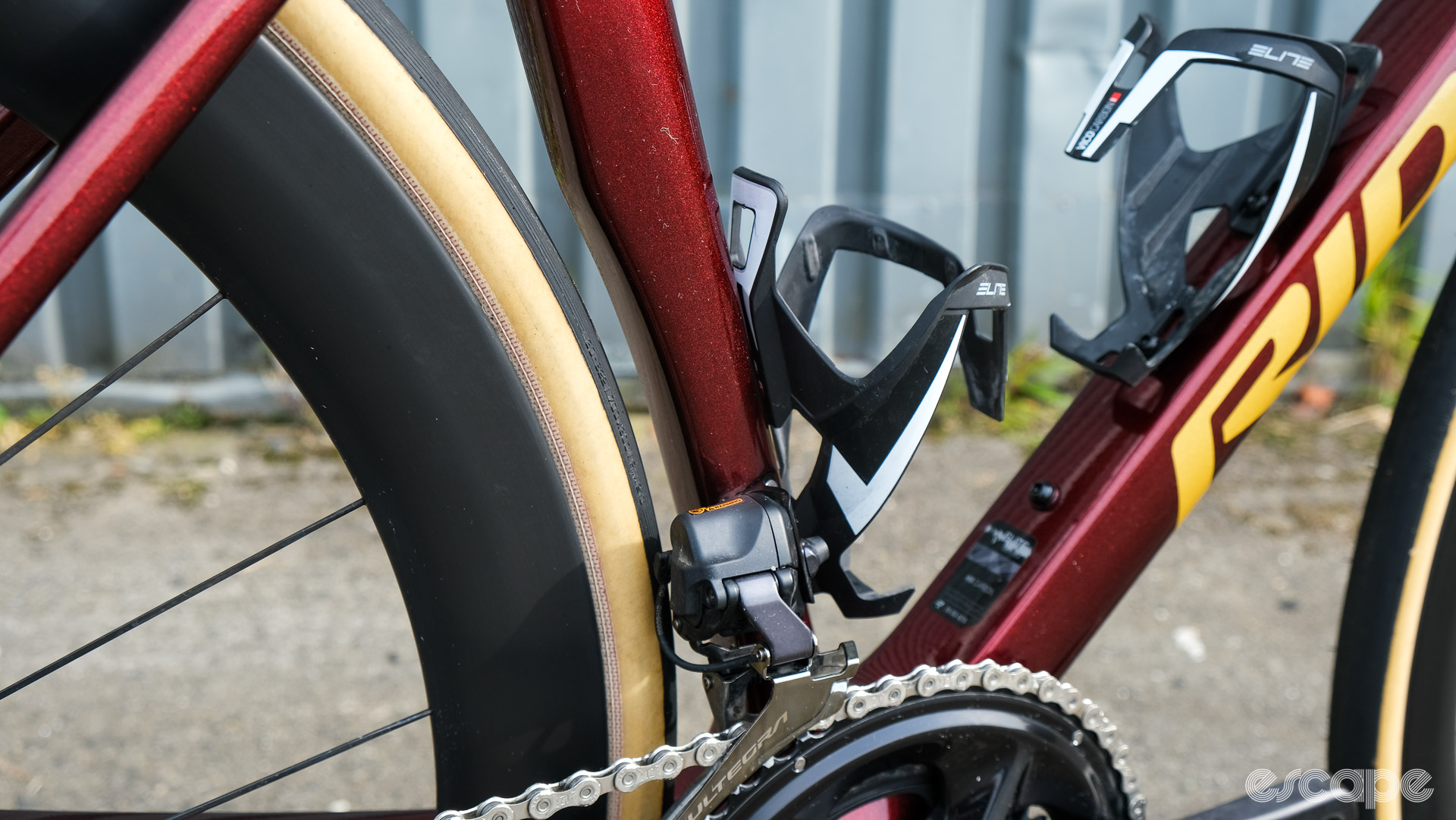
As the final touch on the aero front, the Falcn features upper and lower bottle cage mounting points on the down tube, with the lower providing a slight aero edge over the higher for those who can comfortably reach it while on the road. Nothing new there, but kudos to Ridley for getting the basics right. While not quite “the basics," kudos also to Ridley for including a removable front derailleur mount. It’s another simple thing, and a feature many riders are unlikely ever to use, but for the aero-minded who might run 1X on the right parcours, having the option to remove the derailleur hanger is worth at least a couple of looks-fast-goes-fast psychology watts.
U Do Road?
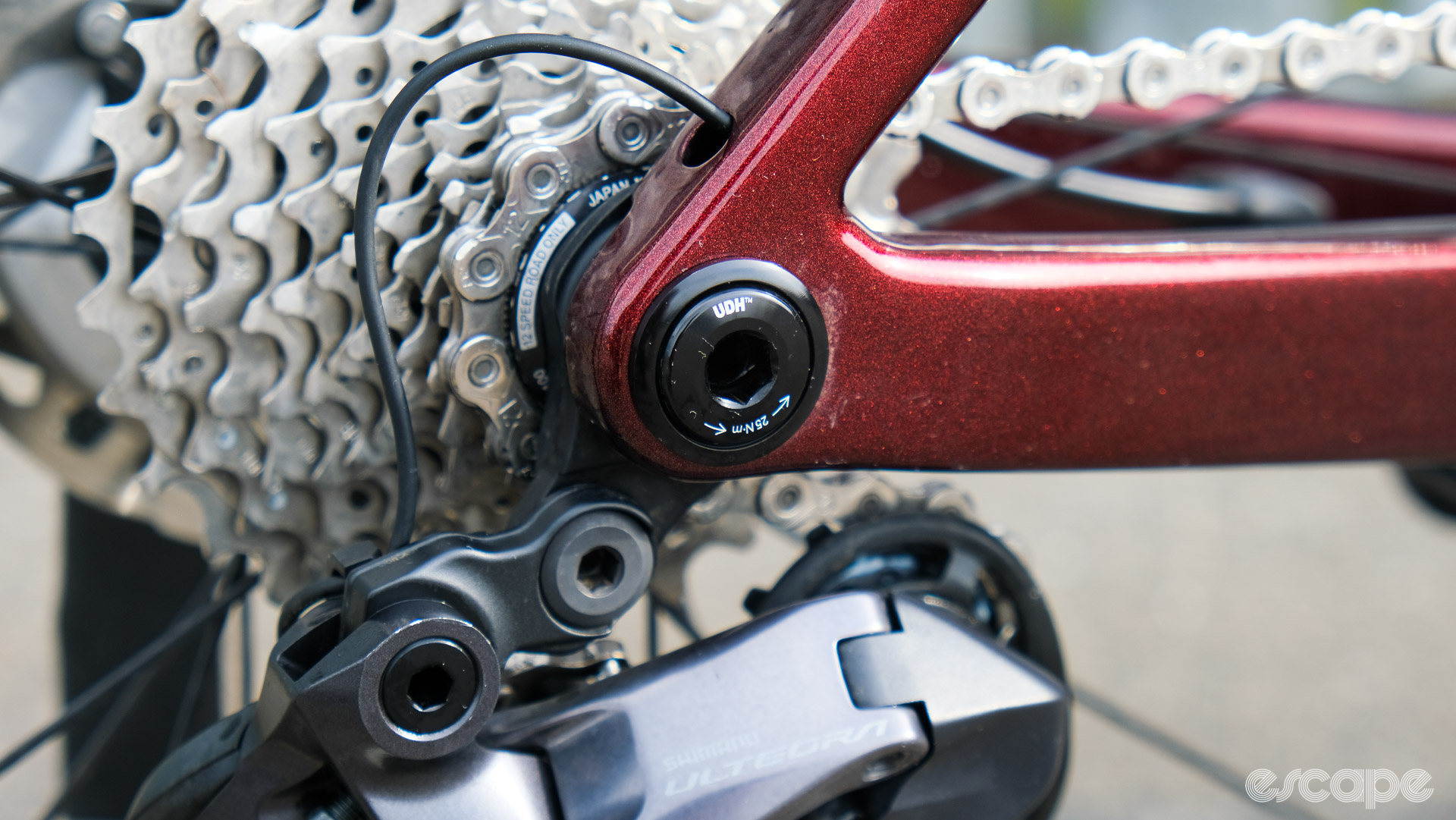
Speaking of derailleur hangers, the new Falcn is one of the first road bikes to feature SRAM’s Universal Derailleur Hanger. As we discussed on a recent Geek Warning podcast, UDH isn’t coming to road, it’s already here. Given many in the off-road space were left feeling like the UDH wasn’t the derailleur hanger nightmare-curing gift to the cycling world we all thought it was, but in fact, some kind of Trojan Horse when SRAM unveiled its T-Type derailleur earlier this year, its wholly understandable our minds immediately jump to what the introduction of UDH in the road space means for future SRAM road groupsets.
To Ridley’s credit, though, they were, as a member of the bike industry, self-deprecating enough to joke, “for the one time there is a universal standard, it's best we adopt it,” before explaining further that the main motivation behind adopting UDH is simplifying things for the end consumer. Ridley gave the example of a rider having a hanger issue, either at home or maybe on holiday, it will be much easier in future to find a UDH at practically any bike shop rather than relying on being lucky enough to have an unlucky hanger issue near a Ridley dealer who also luckily happens to stock the specific hanger for your specific frame. Regardless of what UDH on the road may or may not signal for the future, it’s hard to argue with Ridley’s motivations here.
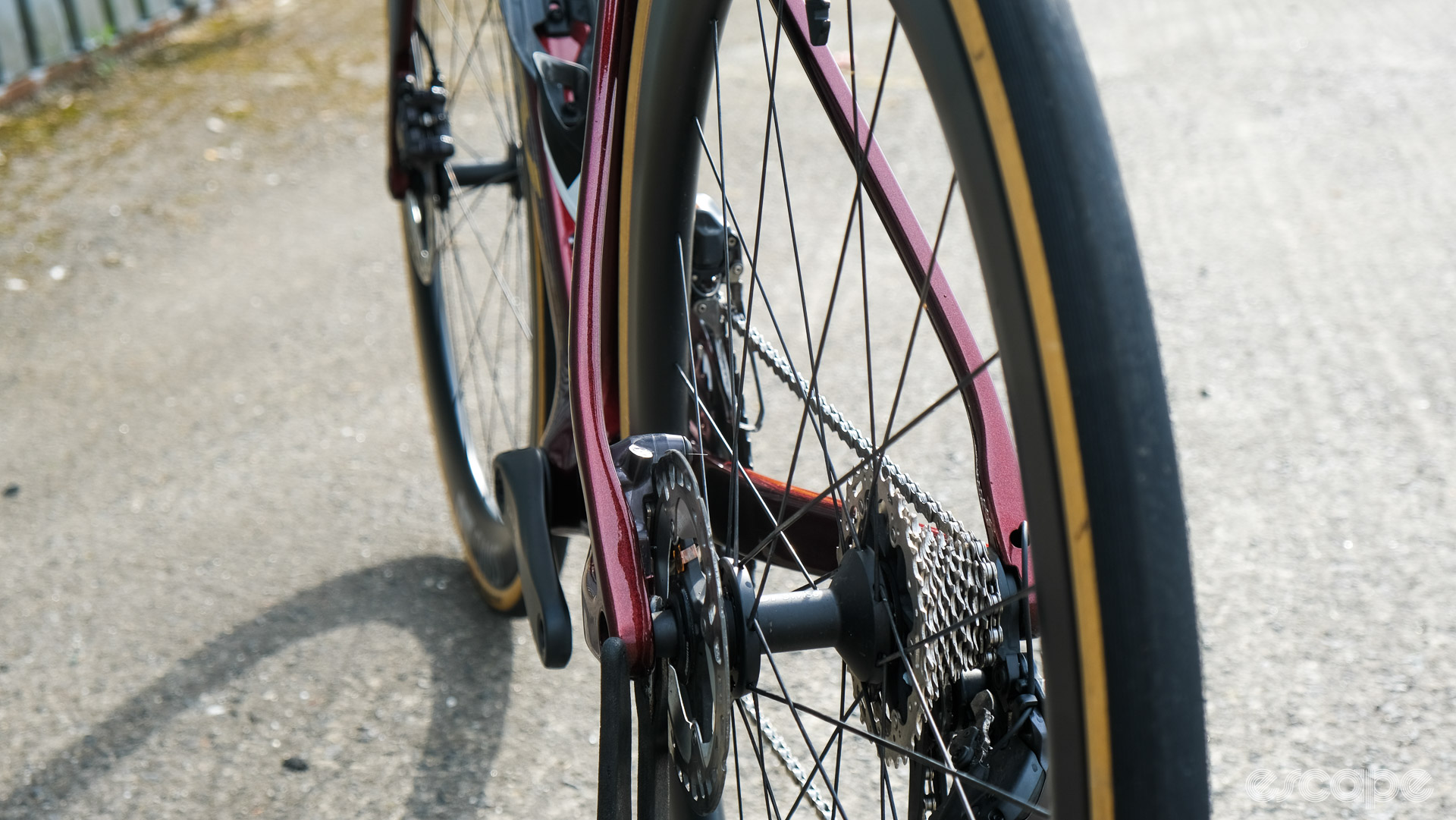
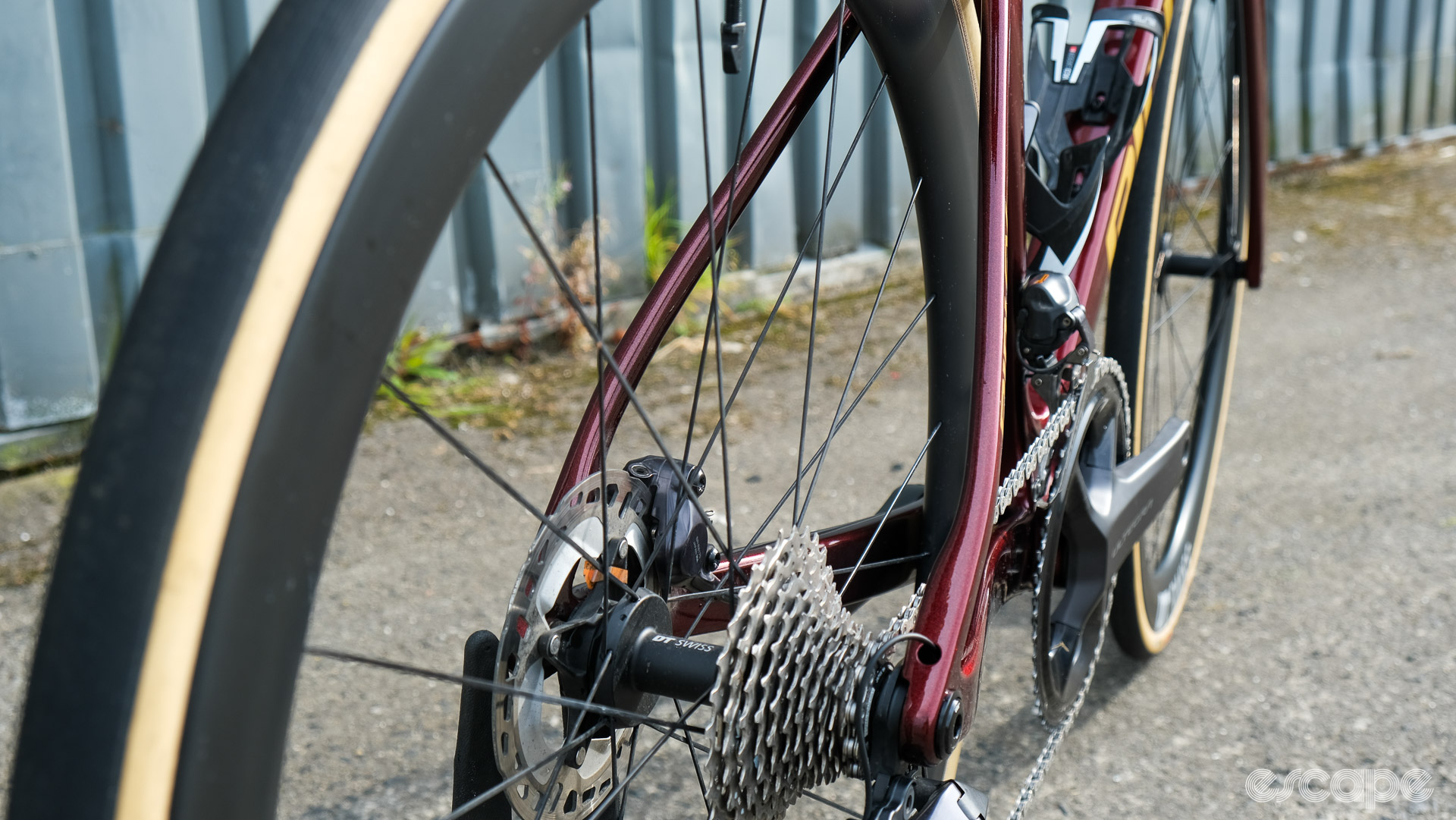
As for what it means for the Falcn design. I had speculated when we saw the Falcn at the Tour that the wide set lower portion of the seat stays may result from implementing the UDH. Not so, says Ridley, who explained it started with a wider seat stay on the non-drive side for easier brake caliper access for servicing, etc., and then simply for the aesthetically pleasing purposes of symmetry, they replicated said flare on the drive side. The aero nerd in me questions that such wide-set stays may have some increased effect on drag. Again, not so, say Ridley.
Speaking of standards, Ridley has stuck with a press-fit BB86 because, according to Ridley, “it offers the best compromise between weight and stiffness." Bert Kenens, product manager at Ridley, explained the brand has “never had any big issues with creaking bottom brackets,” when I asked why the brand didn’t revert to a threaded BB as we have seen so many others do of late. Kenens further explained what we kind of know to be true, “press fit is the best of option for balance between stiffness and weight, if the manufacturer is within the bottom bracket tolerances.” Clearly, Ridley backs itself to hit the tolerances and control its production processes in ways many other manufacturers couldn’t in the past, and were keen to mention threaded systems are not without their flaws either, pointing to issues like threaded inserts coming loose.
A geometry after my heart
Ridley has developed a new geometry for its new road platform based on that from its existing lines but with a more aggressive front end than its sibling, the Noah Fast, or the Helium SLX it replaces. Ridley describes the new geometry as a “balance between speed, stability, and reactivity,” delivering the lower front end its pro riders have requested. To achieve this, Ridley shortened the head tube, dropped the bottom bracket, and slightly increased the chain stay length.
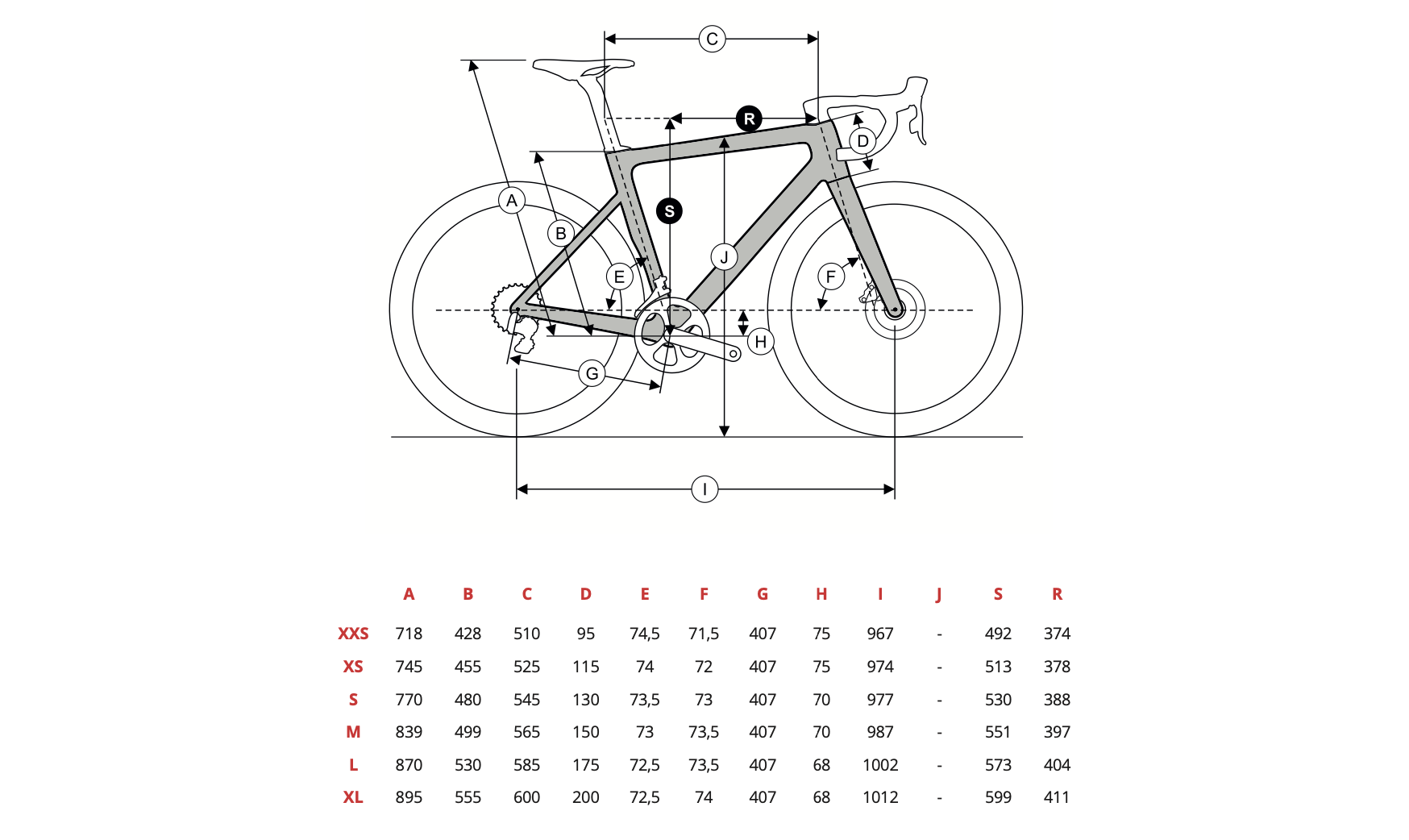
The new bike is available in six sizes from XXS to XL. One word of note for first time Ridley riders: Bert Kenens, product manager, explained “a medium Ridley is in line with a large from a lot of other brands.” Typically, I ride a size large (when sizes are denoted this way), but with Ridleys, I am firmly in the size medium bracket.
With that sizing down in mind, the size medium I have been riding features stack and reach figures of 551 mm and 397mm. While that 397 is a little longer than average, it is within the range I would typically expect from many manufacturers with this style and size of frame. The 551 stack figure, though, is exceptionally low and certainly ticks all the “aggressive position” boxes. I like a low front end, but it is important to consider, and your mileage may vary, especially if you want that slammed stem look. Finally, even though the headset cover is exceptionally low, Ridley suggests it adds just one mm to the stack figure.
Ridley explained the steering geometry is much the same as the existing road range. The 73.5° head angle, 45 mm fork rake, and 28 mm tyres give the Falcn a 55 mm trail for the size medium I tested. The fork Ridley specs on the two smallest sizes in the range features a 50 mm rake, meaning 59 & 62 mm trail figures for the XS and XXS sizes when paired with the slacker head tube angles on these sizes.
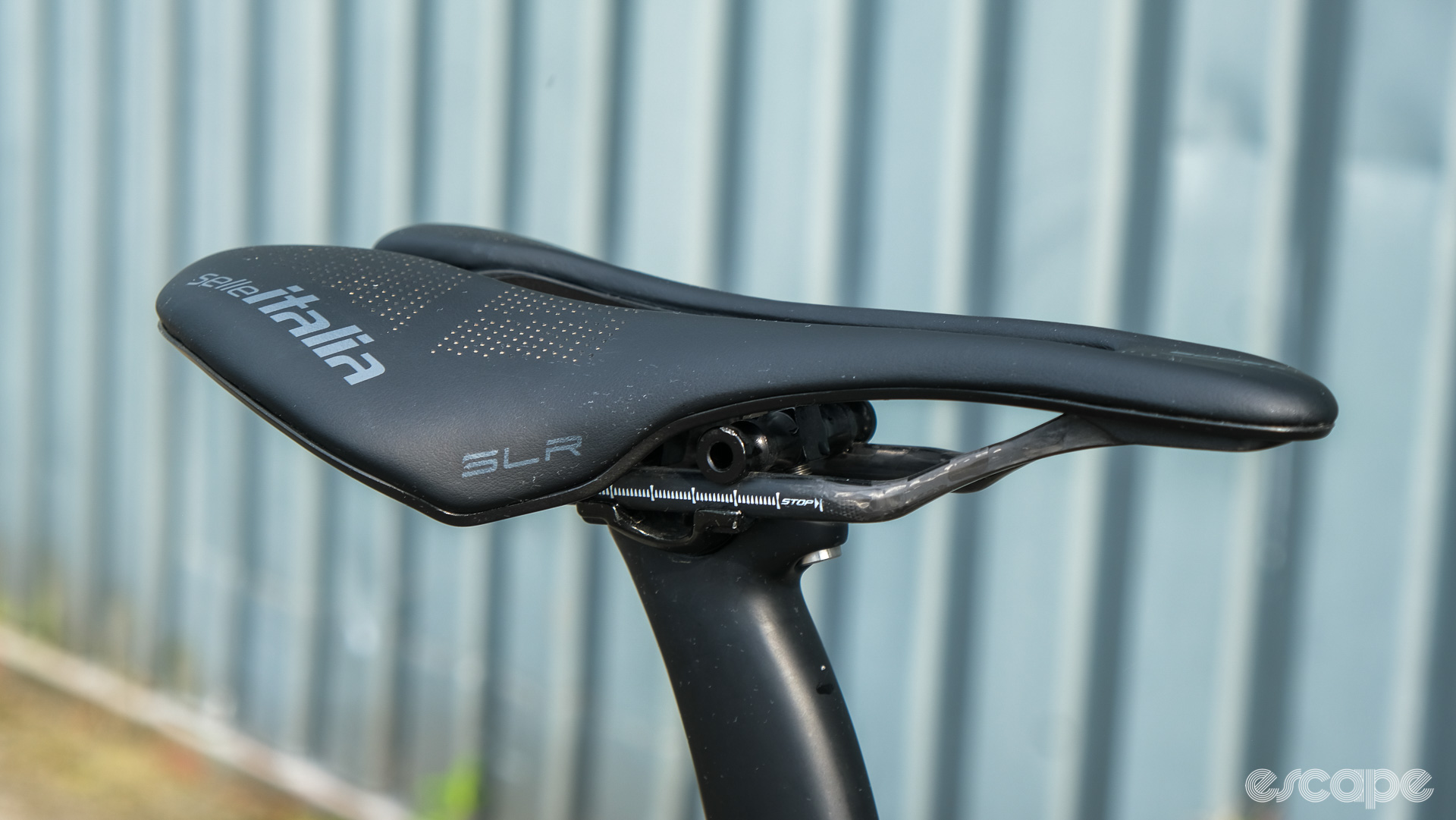
The Falcn RS was delivered with, as you might expect, a proprietary and aero-profiled two-bolt Forza Aero seat post featuring six mm of offset, perhaps designed as a compromise between the forward positions many riders are adopting of late and the more traditional setback positions.
Speaking of modern trends and aero setups, the Falcn does, of course, feature fully internal cable/brake hose routing. Unfortunately, Ridley has not developed some form of hidden cable routing to run the hoses out of the wind but under rather than through the stem. Instead, the brake hoses on the Ultegra Di2-equipped bike I tested are routed through the integrated handlebar and stem and down the rear of the brand’s “F steerer” – similar to what we would commonly refer to as a D-shaped steerer – and through the 1 1/8” top headset bearing. The Falcn Rs features a 1 1/5” lower bearing, relatively standard these days. We could discuss this 'til the cows come home; indeed, we have done so many times. But for the Falcn RS, it is what it is now. Speaking of internal routing, this is probably a good time to mention the Falcn RS is only compatible with electronic groupsets.
Those brake lines are routed through the Cirrus Pro Integrated handlebar and stem from Ridley’s components brand, Forza. The bars feature the same aero-profiled top section as that on the Noah Fast handlebar, a design Ridley claims offers a balance between comfort and aero performance. With 75 mm of reach, 130 mm of drop, and 5° of flare, one could probably describe those dimensions as relatively short but deep enough by modern standards for a performance-focused bike.

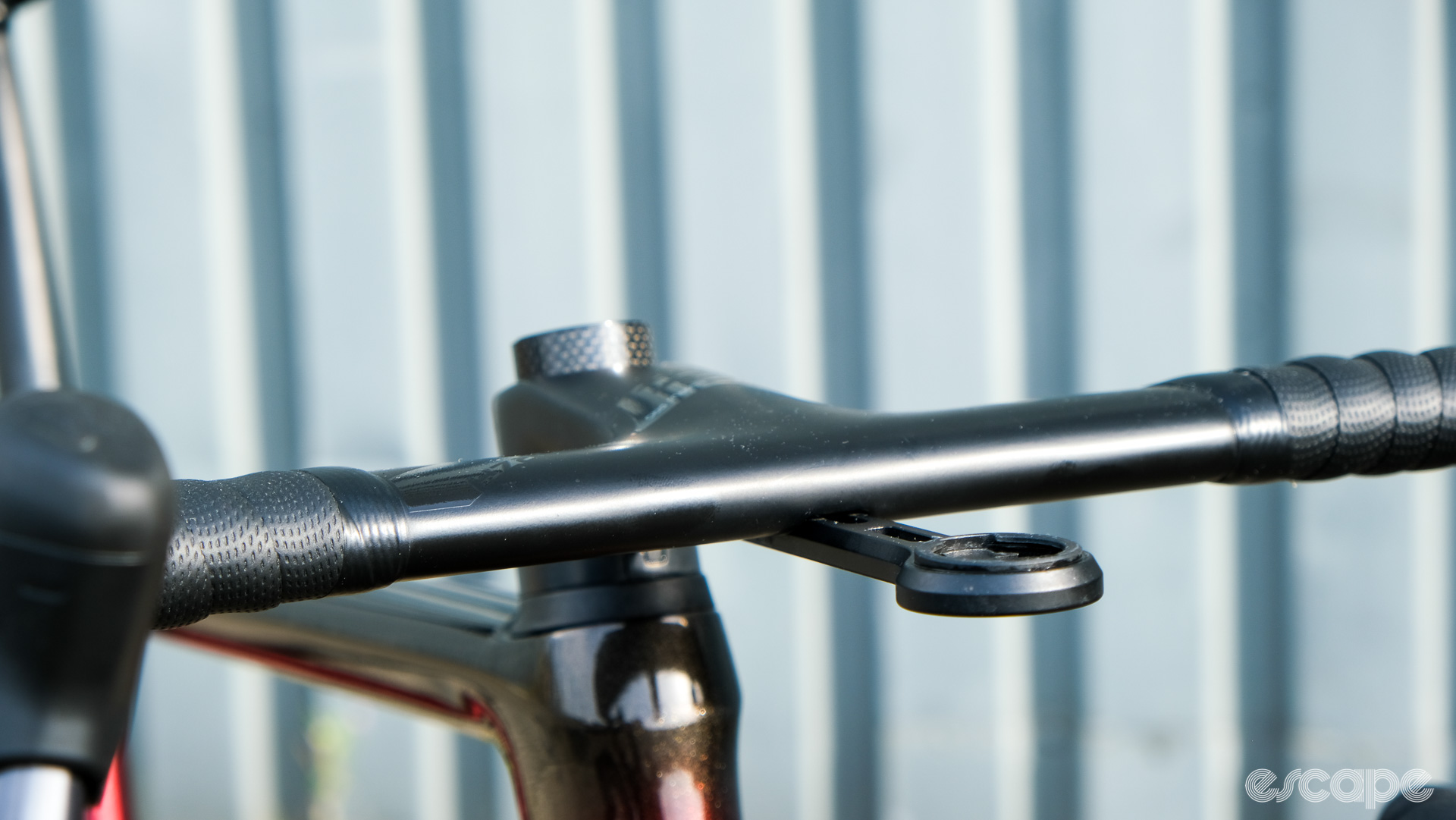
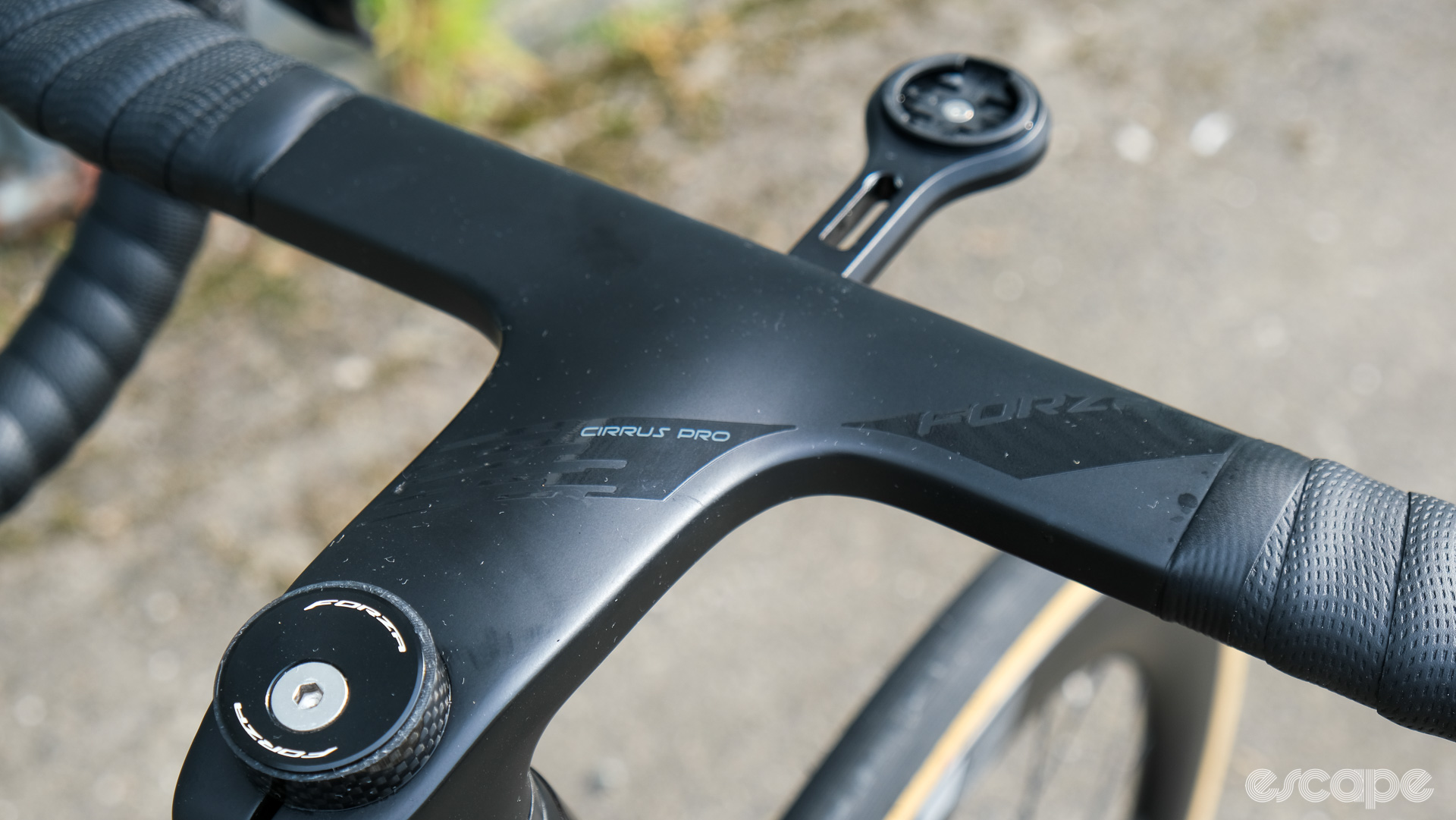
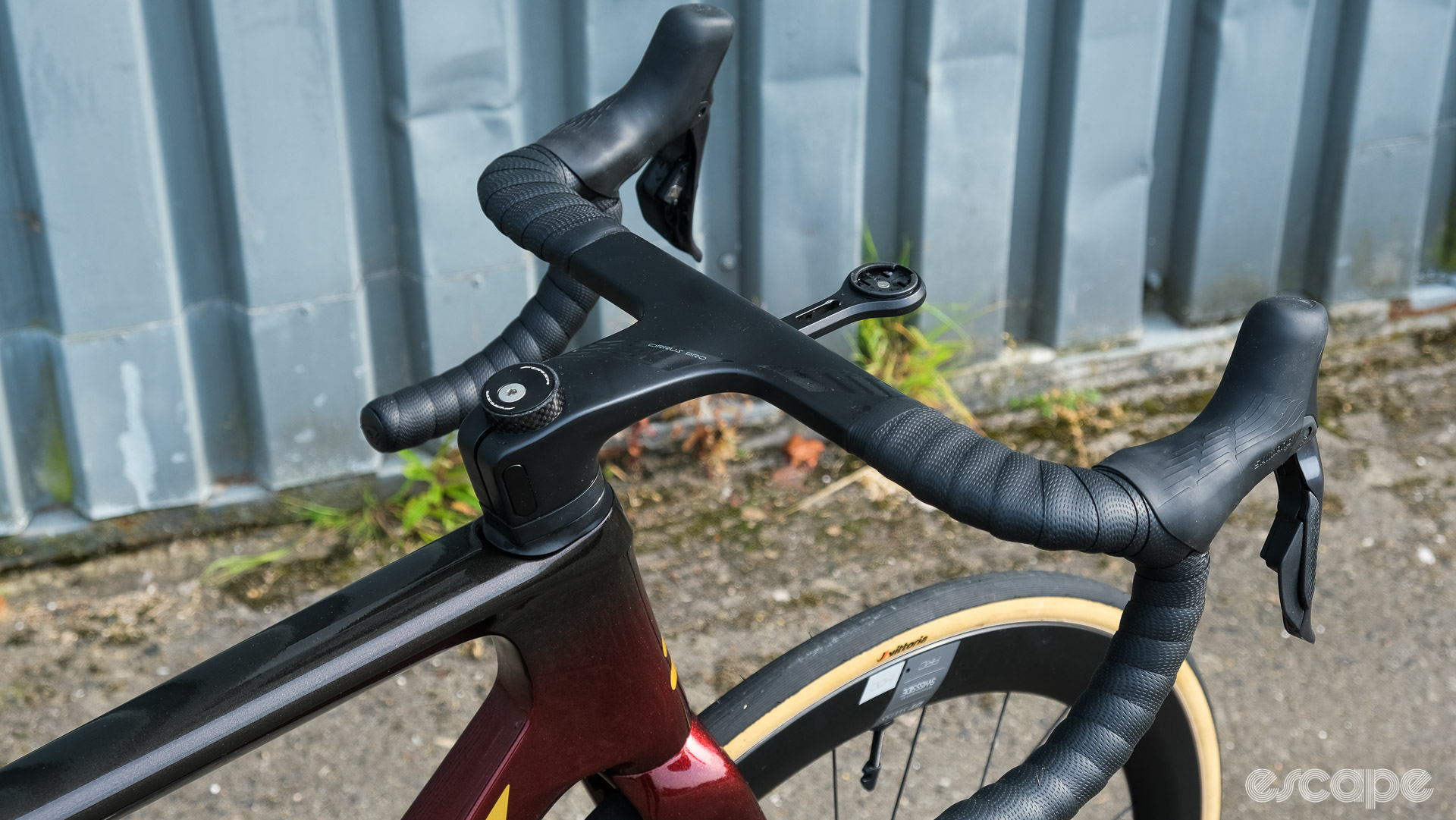
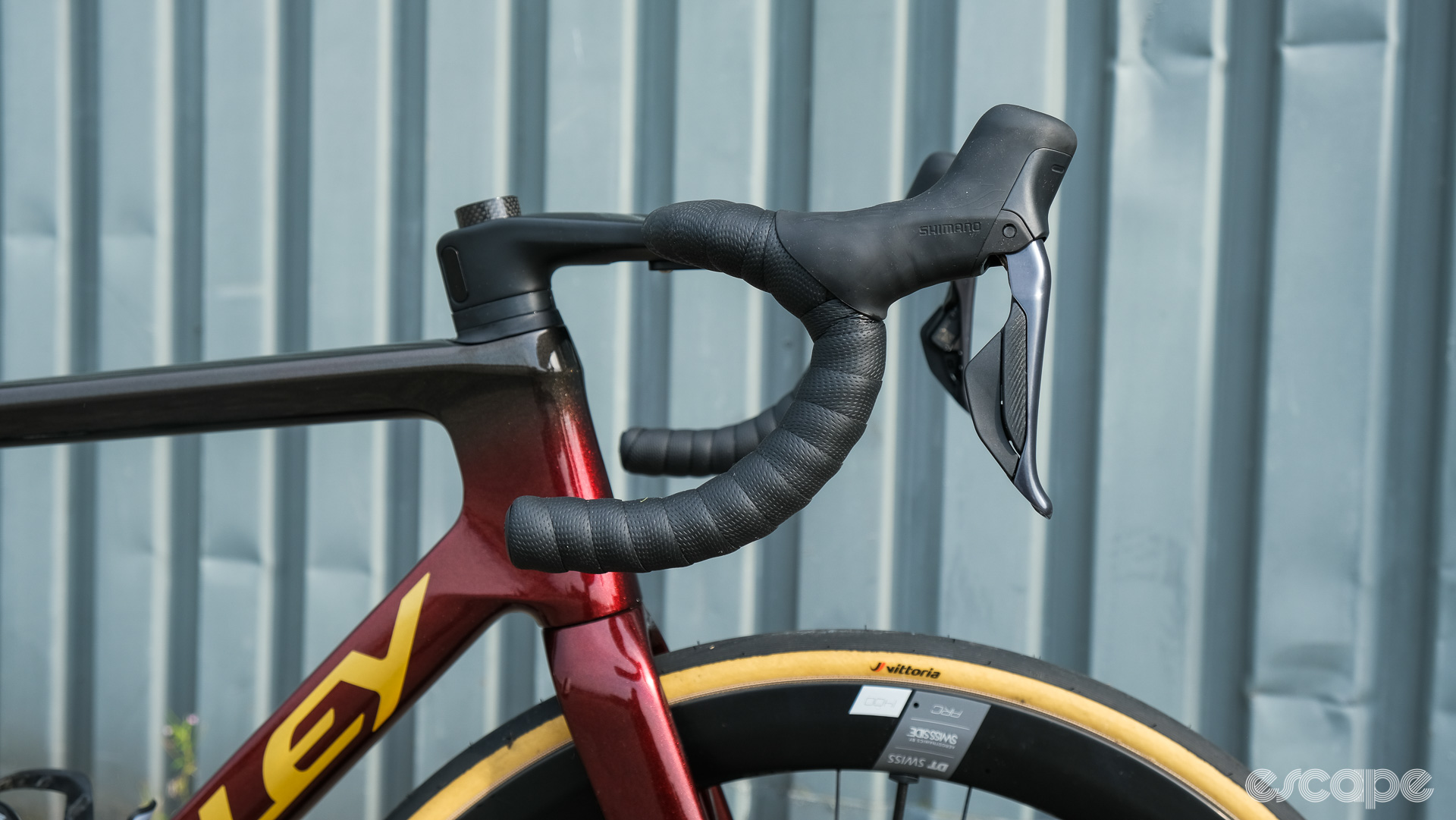
The integrated handlebar comes in four different stem/width sizes: 90/380, 100/400, 110/400 and 120/420. I would describe that as a very limited selection, but to Ridley’s credit, the brand A) are making more sizes which will be available in future and B) customers can specify which size they require when ordering through the online configurator. At press time, we had not yet received confirmation on how much a new integrated handlebar will cost should a rider need to replace one.
Don't take my word for it
The riders on my local group ride know I’m rarely on my own bikes these days, and as such, they know by now that they can give their honest opinion without risking offending someone on their latest purchase. As such, when rider after rider commented on the Falcn’s beauty, that seemed to me a valid measure on a very subjective matter. We don’t typically comment on the highly subjective measure of a bike's beauty, but with so many rave reviews for the Falcn RS, with multiple riders going as far as to say, “that’s the nicest bike you’ve had in a long time, Ronan,” it seems the Falcn is a real crowd pleaser.

I forgot to ascertain if those rave reviews were for the frame itself and the aero-looking but not whacky-looking profiles, or the beautiful burgundy and gold paint job on my test bike, but either way, Ridley has proved as competent as ever in the paint department. Furthermore, the brand will offer custom paint options through the Ridley Configurator.
Configurations
As for build options, Ridley is offering the Falcn RS in three configurations: a SRAM Force Etap AXS or Ultegra Di2 both with DT Swiss ARC 1400 wheels, the Cirrus integrated handlebar, Vittoria Corsa Pro 28 mm tyres, and Selle Italia SLR Boost saddles, both priced at €9,400 / £8,600 / US$12,400.
Alternatively, there is a Shimano 105 Di2 build featuring Forza’s Levanto DB ~1500g carbon tubeless-ready wheels (38mm deep, 19mm internal, 26mm external rim), the same Cirrus handlebar and Corsa Pro tyres, and Selle Italia’s Model Y saddle priced at €7,400 / £6,800 / US$8,250. More on that pricing later.
Including DT Swiss’ ARC 1400 Dicut DB 50 mm (actually 52 mm-deep) wheelset is a real bonus for me. I’ve spent enough time on these wheels over the past two years to know they are as solid as they come, ride exceptionally over any terrain, are built on DT’s 240 Ratchet EXP hubs, and feature a rim profile designed to improve crosswind stability. Granted, the 26.5 mm external rim width has perhaps been outgrown by the almost unanimous shift to 28 mm (or greater) tyres of late, the freehub is louder than I’d opt for, and they are not exactly the cheapest, lightest, or stiffest option on the market, but most will agree they are a much nicer addition to any bike than the house brand wheels included with many bikes these days. The only difference to the top of the line ARC 1100's is the steel bearings in the 240 hubs versus ceramic bearings in DT's 180 hubs and the DT Aero Comp spokes seen here versus the Aerolite spokes on the 1100 wheelset.
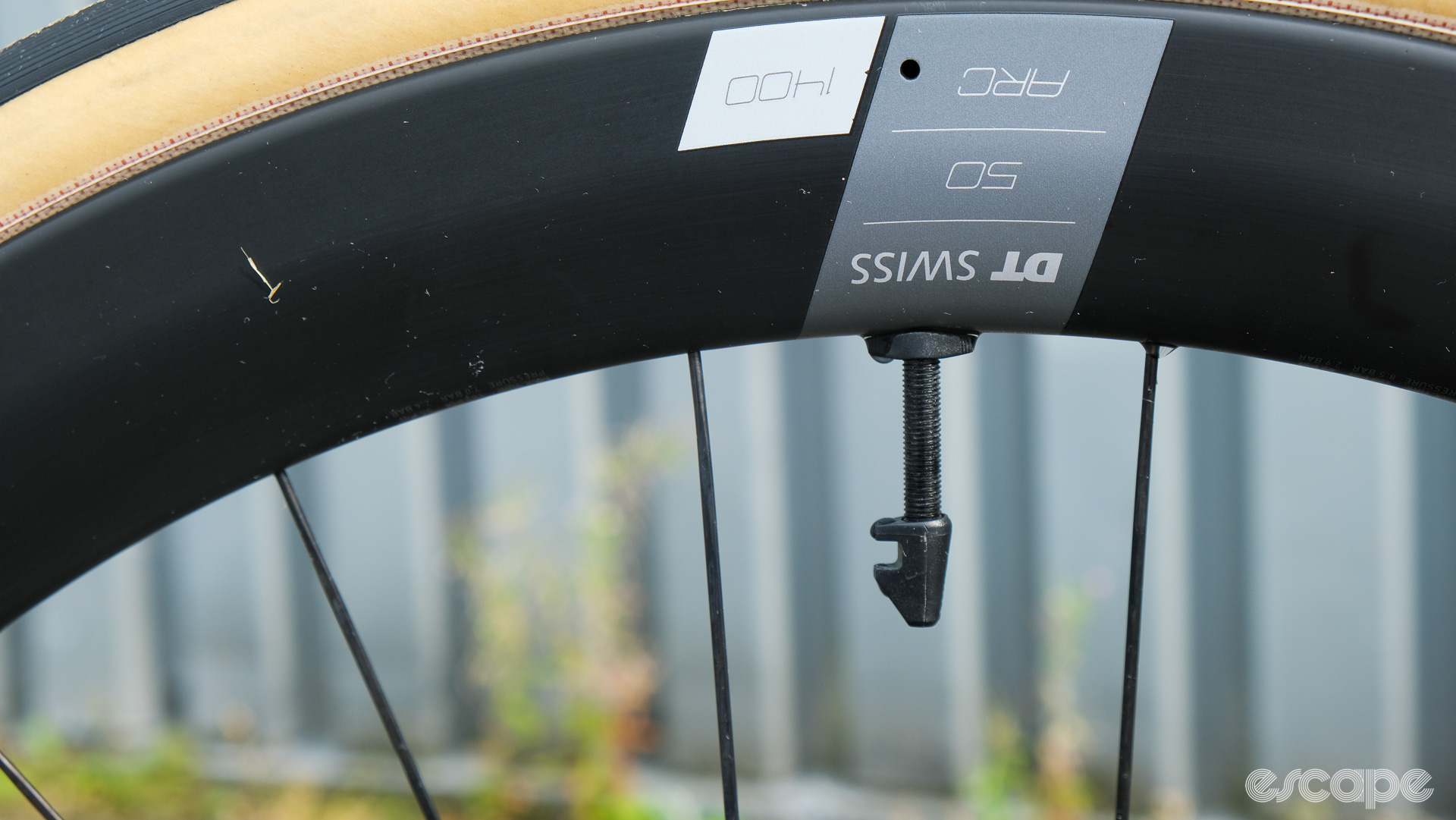
Ride feel
So how does the Falcn ride/fly? Well, a few health issues and the birth of our second child has kept me off the bike for the past three weeks, and while the last few rides I did do were on the Falcn, I by no means expected those to be my last rides on that bike (or any bike) for a while. As such, while I am always making notes when riding a test bike, I didn’t get as long on this bike as I had hoped and certainly didn’t get a chance to do my usual final few rides to check and double-check all my conclusions.
That said, I didn’t need any double-checking to know the Falcn RS is a great race bike. The snappy and agile handling and decently low weight almost defy the reassuringly solid build feel of a bike that seemingly maintains speed quite efficiently. I haven’t had a chance to run the aero testing on this bike as of yet, but it feels fast and certainly not draggy, even if there is no immediate sense of acceleration you might find in the old stiffness : weight-prioritising climbing bikes a la the old Helium.

Ridley spoke a lot of the comfort built into the new Falcn RS, and while I agree the rear end does tame quite a lot of the harsh surfaces I find on my typical training roads, the front end is as stiff and as harsh as they come. Even running the 28 mm tyres sub 60 PSI, the front end is unwavering in its harshness. In fairness, though, a supremely stiff front end is exactly what most of us are going to look for in a performance race bike, especially if you ask the pros for development feedback.
Unsurprisingly, with the 55mm trail for my medium (basically a large) frame, I found the front end very light, nimble, agile, and perhaps best described as pointy. Couple that with the low stack and aggressive positional options that provides, and it is a long time since I felt as at home on a bike. Conversely, it took a while for me to readjust to that from some of the higher and more composed front ends I’ve been riding of late. Time and time again, I found myself having to correct mid-corner, having oversteered the entry expecting the lazier steering of some other bikes and being caught off guard when I got the much more reactive response from the Falcn.
Final thoughts
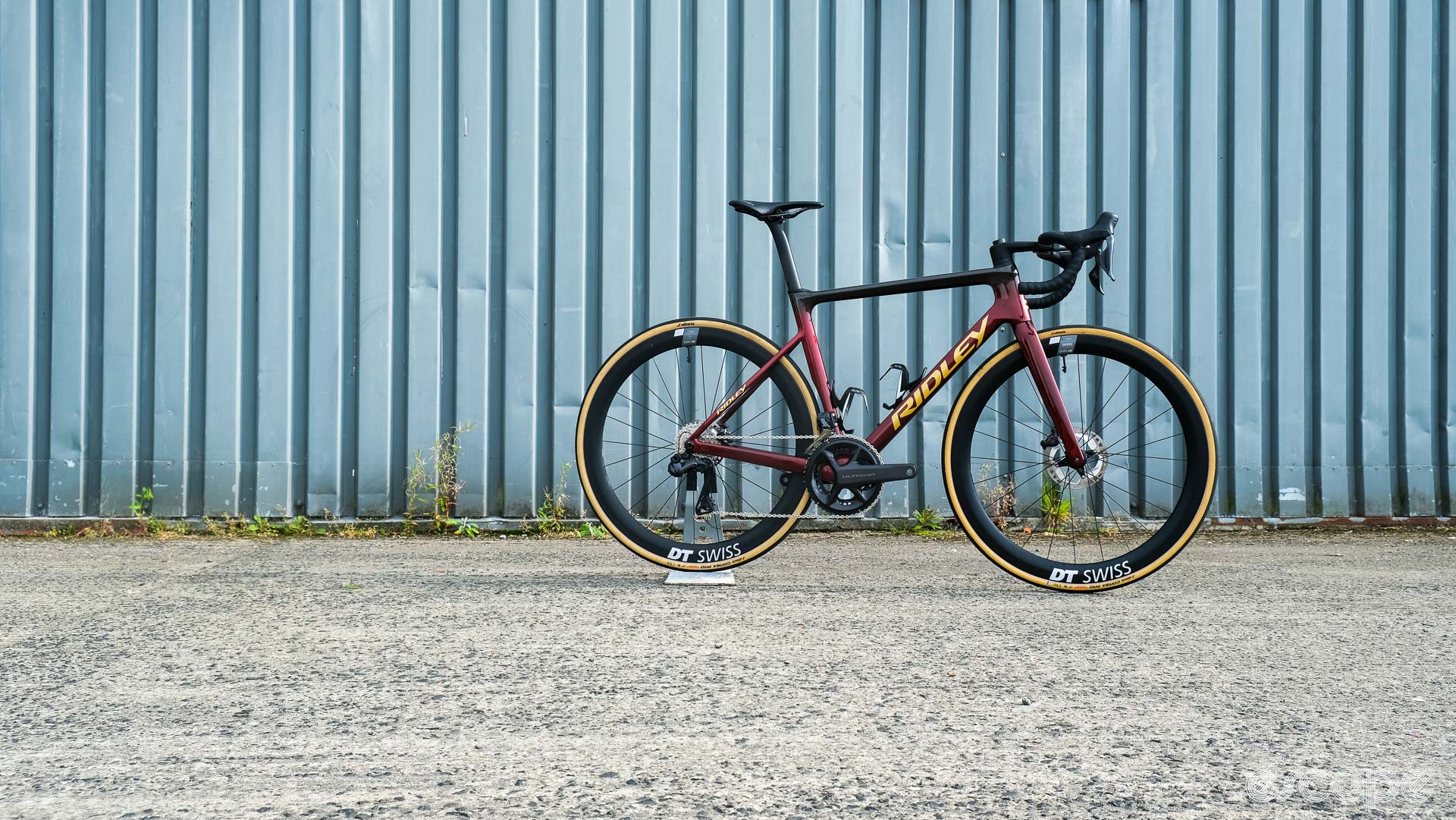
On the whole, I like what Ridley have done with the Falcn RS. It’s a solid bike, solid design, with a solid ride. There’s nothing overly divisive and the bike will probably have many fans. I think on first impressions, it comes across as a bit of a “tick box,” following-the-industry style offering, but it doesn’t take long to realise Ridley has delivered a well-balanced and performant race bike in an appealing package without relying on marketing gimmicks. The aero tech is there if you want it, but it's not in your face. Sure, the very stiff front end won’t be to everyone’s liking, but it is in keeping with the performance focus of this bike, in my opinion.
The only real downside is the pricing. As far as top-end bikes go these days, the Falcn RS is far from the priciest, but that’s far from a compliment. At just above and below nine grand in Euro and Sterling markets and a whopping US$12,400, whatever sprouts of normalisation of prices we thought might be on the horizon clearly haven’t matured yet. That’s a real shame if you ask me.
As mentioned above, Ridley has delivered a performance bike. They have ticked many boxes others have missed, but sadly, it won’t be an accessible performance for many. Heck, a similarly equipped Specialized Tarmac SL8 is £600 less expensive than the Falcn RS, a Cannondale SuperSix Evo Hi-Mod 2 stings £400 less. The gaps to prices in those brands' home US market are even more glaring, as the Tarmac SL8 runs US$8,500 with Force or Ultegra, and the Ultegra-equipped SuperSix Evo Hi-Mod 2 is US$8,300, a roughly $4,000 savings to the Falcn RS.
Arguably the addition of the DT Swiss wheels, Vittoria’s newest Corsa Pro tyres, a carbon-railed lightweight saddle, and integrated handlebars are all ticks in the Falcn’s favour over some other bikes at this price point, but damn, if only Ridley could have found a way to make this more accessible to all it wouldn’t just have a new all-rounder bike, but easily the new benchmark all-rounder bike in the market.
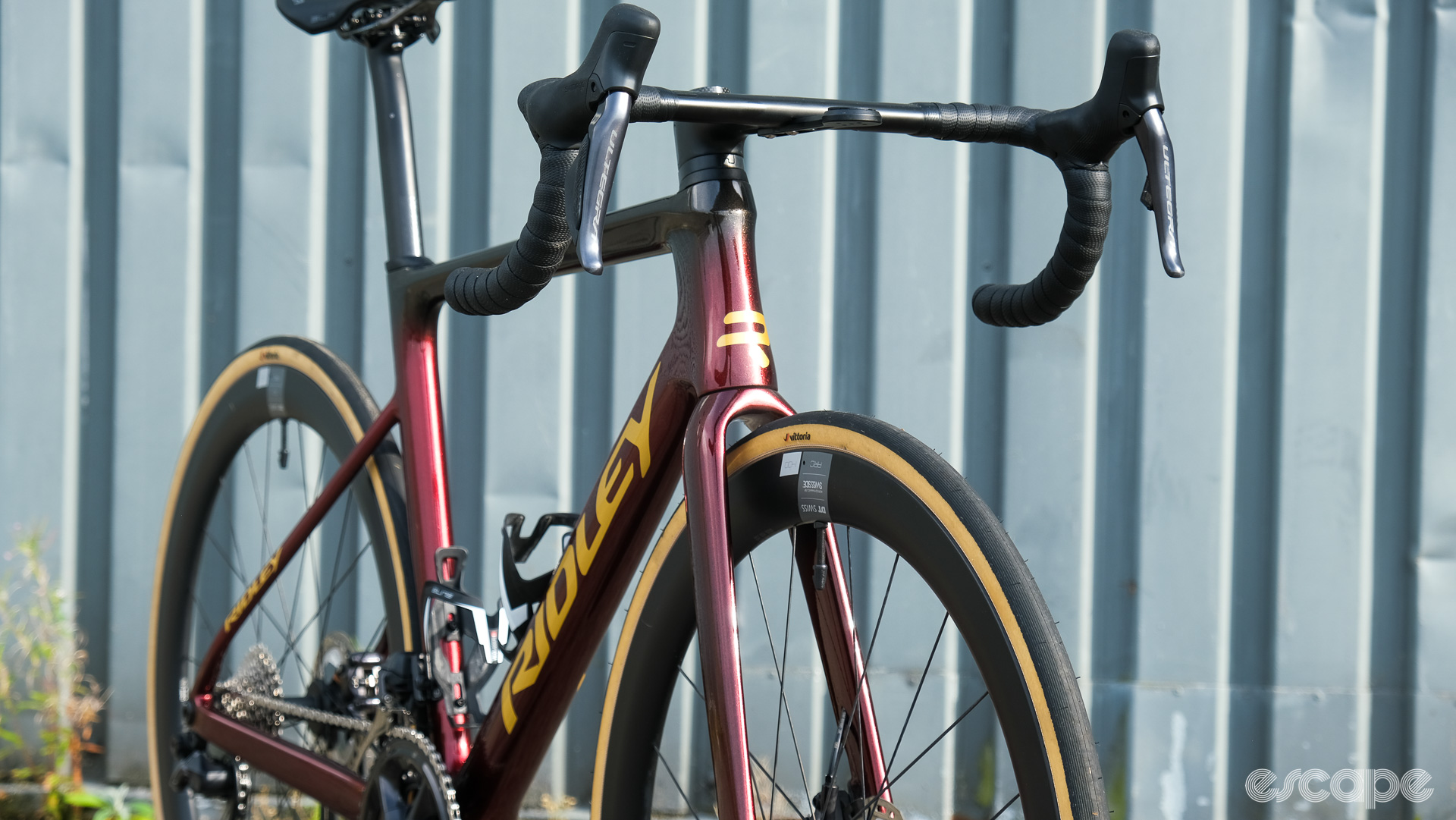
Pricing aside, I like the Falcn RS, I’ll go a step further and say; I’d like to own a Falcn RS. Back to "it’s a strange wind that doesn’t blow some good,” if a new team lands on Ridley bikes following Lotto’s early termination, that team should feel that good wind in the form of Ridley’s new Falcn.
Did we do a good job with this story?



